

How to Write a Chinese Essay
Dec 16, 2020 | Guest Blogs & Media
The more essays you write, the better you get at communicating with Chinese. To write a good essay, you first have to reach a high language mastery level.
Do you admire the students who write seamless Chinese essay? If you do, then you should know that you too can achieve this level of proficiency. In the meantime, don’t be afraid to pay for your essay if you cannot write it on your own. Online academic writers are a resource each student should take advantage of.
Here are tips to help you get better at writing essays in Chinese.

Learn New Chinese Words
The key to communicating in a new language is learning as many words as you can. Take it upon yourself to learn at least one Chinese word a day. Chinese words are to essay writing what bricks are to a building. The more words you have, the better you get at constructing meaningful sentences.
Case in point, if you’re going to write a Chinese sentence that constitutes ten words, but you don’t know the right way to spell three of those words, your sentence might end up not making sense.
During your Chinese learning experience, words are your arsenal and don’t forget to master the meaning of each word you learn.
Read Chinese Literature
Reading is the most effective way of learning a new language. Remember not to read for the sake of it; find out the meaning of each new word you encounter. When you are an avid reader of Chinese literature, nothing can stop you from writing fluent Chinese.
In the beginning, it might seem like you’re not making any progress, but after a while, you will notice how drastically your writing will change. Receiving information in Chinese helps your brain get accustomed to the language’s sentence patterns, and you can translate this to your essays.
Be extensive in your reading to ensure you get as much as possible out of each article. Remember that it’s not about how fast you finish an article, but rather, how much you gain from the exercise.
Translate Articles from your Native Language to Chinese
Have you ever thought about translating your favorite read to Chinese? This exercise might be tedious, but you will learn a lot from it. The art of translation allows you to seamlessly shift from one language’s sentence pattern into the other. The more you do this, the easier it will be for your brain to convert English sentences into Chinese phrases that people can comprehend.
You can always show your Chinese professor your translations for positive criticism. The more you get corrected, the better you will get at translation. Who knows, you might actually like being a translator once you graduate.
Final Thoughts

by Adrian Lomezzo
Adrian Lomezzo is a freelance writer. Firstly, he has been developing as a content manager and working with different websites, and the main goal of his was to develop the content making it in the first place. Secondly, Adrian had a big desire to help students and adults in self-development in this field and teach them to improve their skills. As a lover of traveling, he did not want to be in one place, and became a writer who could be closer to everyone, and share precious information from the corners of the world.
Submit a Comment Cancel reply
Your email address will not be published. Required fields are marked *
Submit Comment
Other posts you might like

Congratulations That’s Mandarin Winter 2022 Graduates
Mar 31, 2022 | Beijing , News
We’re so excited and proud to see our students achieve goals and improve their Chinese skills at That’s Mandarin. We know how hardworking and diligent you are and we are happy to go through this incredible and at times difficult process of learning Chinese together...

News: NihaoKids Website Is Live!
Mar 3, 2022 | News , Online
A modern place for your children to learn Mandarin Chinese.

Mahjong Night Recap (Feb 23)
Feb 24, 2022 | Beijing , News , Shanghai
The best moments of Mahjong Night!
Get 2-week FREE Chinese Classes
Original Price: ¥ 600


Improve Chinese Essay Writing- A Complete How to Guide
- Last updated: June 6, 2019
- Learn Chinese
Writing can reflect a writer’s power of thought and language organization skills. It is critical to master Chinese writing if you want to take your Chinese to the next level. How to write good Chinese essays? The following six steps will improve Chinese essay writing:
Before You Learn to Improve Chinese Essay Writing
Before you can write a good essay in Chinese, you must first be accustomed with Chinese characters. Unlike English letters, Chinese characters are hieroglyphs, and the individual strokes are different from each other. It is important to be comfortable with writing Chinese characters in order to write essays well in Chinese. Make sure to use Chinese essay writing format properly. After that, you will be ready to improve Chinese essay writing.
Increase Your Chinese Words Vocabulary
With approximately 100,000 words in the Chinese language, you will need to learn several thousand words just to know the most common words used. It is essential to learn as many Chinese words as possible if you wish to be a good writer. How can you enlarge your vocabulary? Try to accumulate words by reading daily and monthly. Memory is also very necessary for expanding vocabulary. We should form a good habit of exercising and reciting as more as we can so that to enlarge vocabulary. Remember to use what you have learned when you write in Chinese so that you will continually be progressing in your language-learning efforts.
Acquire Grammar,Sentence Patterns and Function Words
In order to hone your Chinese writing skills , you must learn the grammar and sentence patterns. Grammar involves words, phrases, and the structure of the sentences you form. There are two different categories of Chinese words: functional and lexical. Chinese phrases can be categorized as subject-predicate phrases (SP), verb-object phrases (VO), and co-ordinate phrases (CO). Regarding sentence structure, each Chinese sentence includes predicate, object, subject, and adverbial attributes. In addition, function words play an important role in Chinese semantic understanding, so try to master the Chinese conjunction, such as conjunction、Adverbs、Preposition as much as you can. If you wish to become proficient at writing in Chinese, you must study all of the aspects of grammar mentioned in this section.
Keep a Diary Regularly to Note Down Chinese Words,Chinese Letters
Another thing that will aid you in becoming a better writer is keeping a journal in Chinese. Even if you are not interested in expanding your writing skills, you will find that it is beneficial for many day-to-day tasks, such as completing work reports or composing an email. Journaling on a regular basis will help you form the habit of writing, which will make it feel less like a chore. You may enjoy expressing yourself in various ways by writing; for instance, you might write poetry in your journal. On a more practical side of things, you might prefer to simply use your journal as a way to purposely build your vocabulary .
Persistence in Reading Everyday
In addition to expanding your view of the world and yourself, reading can help you improve your writing. Reading allows you to learn by example; if you read Chinese daily, you will find that it is easier to write in Chinese because you have a greater scope of what you can do with the vocabulary that you’ve learned. Choose one favorite Chinese reading , Read it for an hour or 2,000 words or so in length each day.
Whenever you come across words or phrases in your reading that you don’t understand, take the time to check them in your dictionary and solidify your understanding of them. In your notebook, write the new word or phrase and create an example sentence using that new addition to your vocabulary. If you are unsure how to use it in a sentence, you can simply copy the sample sentence in your dictionary.
Reviewing the new vocabulary word is a good way to improve your memory of it; do this often to become familiar with these new words. The content of reading can be very broad. It can be from novels, or newspapers, and it can be about subjects like economics or psychology. Remember you should read about things you are interested in. After a certain period of accumulation by reading, you will greatly improve your Chinese writing.
Do Essay Writing Exercise on a Variety of Subjects
As the saying goes, “practice makes perfect.” In order to improve your China Essay Writing , you should engage in a variety of writing exercises. For beginners, you should start with basic topics such as your favorite hobby, future plans, favorite vacation spot, or any other topic that you can write about without difficulty.
For example :《我的一天》( Wǒ de yì tiān, my whole day’s life ),《我喜欢的食物》( Wǒ xǐhuan de shíwù, my favorite food ),《一次难忘的旅行》( yí cì nánwàng de lǚxíng, an unforgettable trip ) etc.
Generally the writing topics can be classified into these categories: a recount of an incident,a description of something/someone, a letter, formulate your own opinion on an issue based on some quote or picture etc.
Takeaway to Improve Chinese Essay Writing
Keep an excel spreadsheet of 口语(Kǒuyǔ, spoken Chinese) –书面语(Shūmiànyǔ, written Chinese) pairs and quotes of sentences that you like. You should also be marking up books and articles that you read looking for new ways of expressing ideas. Using Chinese-Chinese dictionaries is really good for learning how to describe things in Chinese.

Online Chinese Tutors
- 1:1 online tutoring
- 100% native professional tutors
- For all levels
- Flexible schedule
- More effective

Qin Chen focuses on teaching Chinese and language acquisition. She is willing to introduce more about Chinese learning ways and skills. Now, she is working as Mandarin teacher at All Mandarin .
You May Also Like

This Post Has 3 Comments
When I used the service of pro essay reviews, I was expecting to have the work which is completely error free and have best quality. I asked them to show me the working samples they have and also their term and condition. They provided me the best samples and i was ready to hire them for my work then.
This is fascinating article, thank you!
Thank you so much for sharing this type of content. That’s really useful for people who want to start learning chinese language. I hope that you will continue sharing your experience.
Leave a Reply Cancel reply
Your email address will not be published. Required fields are marked *

Grammar , Vocabulary
Useful Chinese Essay Phrases
July 8, 2020
By Ellen

Nowadays, many international students have decided to study abroad, and China has become a highly popular destination. In universities, essay writing is a basic skill and the “Academic Writing” lectures are always attracting many students to attend.
Here we have summarized some “all-purpose” phrases and sentences which hopefully you would find useful.
Chinese Essay Phrases Used in Abstracts
The abstract should explain the purpose, method, results, and conclusion of your research, also highlighting the new ideas that you proposed; and do remember to keep your language concise while writing. The purpose of the abstract is to conclude and summarize the main contents of your essay so that the reader could have a brief understanding without having to read the entire paper. Chinese abstracts are usually around 200 characters.
Research Background, Significance, and Current Situation
Extremely useful/badly needed/affecting people’s lives (1-2 sentences)
Proposing the Object of Study
Played a very important role (1-2 sentences)
Purpose of the Study or Study Aim
The role of A in B, perhaps remains to be seen (1 sentence)
Research Methods and Results
Through what means/technique/experiment we achieved what result (several sentences)
Research Results
The phenomenon of A in B, shows what the function of B is, theoretical and applied value (1-2 sentences)

via Pixabay
Chinese Essay Phrases: Main Body
The main body includes the introduction and the main text. The introduction section could use similar phrases that we have just listed, focusing on research objects and purposes. The main text should include research methods, research results, and discussion. Writers should keep their sentences to the point and avoid rambling, also avoid using too much subjective perspective discourses, which shouldn’t be used as arguments as well.
Theoretical Basis, Approaches, and Methods
To express opinions, to emphasis, transitional expressions, chinese essay phrases: conclusion.
At the ending section of the paper, the writer should provide an objective summary, list out the future research objectives and directions, and perhaps look into the future. Keep optimistic even if your experiment results were negative.
Research Impact and Value
There you go. We hope this article helps you write amazing essays. Best of luck!
Ellen is a language specialist from China. She grew up in the US and received a master’s degree from the St Andrews University of UK. The multicultural experiences attributes to her understanding of the differences and similarities between the English and Chinese language. She currently works as an editor specialized in Language learning books.
related posts:
Must-Try Authentic Chinese Dishes
15 must-watch chinese movies for language learners, best chinese music playlists on spotify, get in touch.
- Be a Member
- English French Chinese
- General Chinese learning tips
How to Write a Good Chinese Essay
Posted by Lilian Li 17816
For any kind of language, the essay is the most difficult thing to do in the exam. Generally speaking, writing articles is just to tell a story, after you make the story clear, the article also is finished. But it also different with speaking. A good article is like a art, is worth for people to appreciate, to taste. But how to accomplish such a good art? I think the most important thing is the three points: attitude, subject matter, emotional.
A good beginning is half done. For writing, material selection and design are not the start. The most important thing still is to adjust their mentality as well. When you decided to write, then dedicated yourself to write, not half-hearted, and your thinking nature won't be upset. Once the train of thought was interrupted, your speed will be slow and the point will be word count. So how can you write down a interesting article with a good quality? All in all, attitude is can decide the success or failure of the articles.
Subject is the biggest problem in our writing. It is from life, but not all people can observe life, experience life. The only point is to write the true things, maybe not so tortuous plots, but can write a really life. Moreover, when you get the subject, there are some tips for students to pay attention:
1. Make the topic request clear: The article should around the topic, pay attention to the demand of genre and number of words, some restrictive conditions and avoid distracting, digression.
2. Determine the center, choose the right material. To conform to the fact that a typical, novel, so it’s easy to attract the attention of people.
3. Make a good outline, determine the general, write enough words.
4. Sentence writing smooth, there is no wrong character, no wrong grammar in article.
Emotion, it is very important. If we compared an article to be a human. So emotion is his soul. Man is not vegetation, when they meet something, there must be personal thoughts and feelings. Sometimes it also tend to have their own original ideas. If you can put your own thoughts, feelings and insights into the article, then this article will be very individual.
Chinese essay is not just meaning some simple Chinese characters and make a simple sentences, it needs the Chinese grammar and sentence structure, if you don't familiar with Chinese grammar, you can learn our Chinese grammar course .
At last, adhere to write diary at ordinary times, it can practicing writing. Try to read some good articles, good words and good paragraphs with a good beginning and end. Learn to accumulate and draw lessons from them.
If you are interested in our Chinese grammar course, you can try our one online free trial , you will enjoy it.
About The Author
Related articles.

Free Trial

Self-test

Concat Us

Chat online

Share Us
Want to receive regular Chinese language tips & trivia?
The Guide to Writing Your First Mandarin Essay
When you want to be able to make writing your first Mandarin essay nice and easy, it pays to put plenty of thought and effort into the preparation. As the old saying goes ‘fail to prepare, prepare to fail.’ To give you plenty of food for thought we’ve put together everything you need to know to get things moving. All you need to do is work through the following steps, and you’ll be submitting your essay in no time at all.
Check you understand the basics
There are so many things you have to think about when writing an essay, particularly when it’s not in your native language. But as with any cognitively demanding task, the process for getting started is always the same. Check you understand the following basics and you’ll be heading in the right direction:
- Do you know what the question means?
- Have you made a note of the final submission date?
- Make sure you read some past examples to get a feel for what’s expected of you
- Do you understand the question that has been set?
- Do you know who you can talk to if you need advice along the way?
- Are there any restrictions on the dialect you should be aware of?
Once you can write the answers to the above down on a single side of the paper, you are ready to tackle the main part of the problem: putting pen to paper.
Set aside time to write
The chances are that you’re not going to be able to pen the entire essay in a single sitting, and that’s okay. It’s nothing to be ashamed of or to worry about, and it’s natural that you need to work across multiple days when writing your first essay.
If you want to be able to make great progress, the most important thing is sticking to a routine. You need to have consistency in your application, and you need to be able to know when you are at your most productive. It’s no good staying up late one night and then carrying on early the next morning. You’d be far better off writing for the same amount of time but on two successive afternoons. Think about how your studies fit in with the rest of your daily life, and then choose the time that seems most appropriate. If you box it off and decide it’s only for writing, you’ll be in a great routine before you even know it.
Clear space so you can focus
As well as having time to write each day, you need a place to write too. The world is full of distractions (most of them are digital and social) so that means you’re going to want to keep yourself to yourself, and your phone in a different room. It might seem a little boring or uncomfortable at first, but you need to practice the habit of deep work. It’s what will allow you to create the most in the shortest time — ideal if you want to have plenty of time leftover to spend doing the other things that matter to you.
Have a daily word count in mind
Telling yourself that you want to write an essay today is one thing, but if you’re really going to push yourself to stick to your goal then you need to get quantitative. If you have a word count in mind that you need to hit, then it will prevent you from giving up and throwing in the towel the minute you start having to think and concentrate more than feels normal. Just like working out in the gym, it’s the temporary moments of extra effort that really drive the big differences. It’s when you’ll see the biggest improvement in your writing ability, and the lessons you teach yourself will stay with you for years to come. Ideal if you want to become a fluent Mandarin writer, as well as an engaging face-to-face speaker.
Read widely to provide context
When you’re immersed in an essay it can be all too easy to become blinkered and fail to pay attention to everything else that’s going on around you. Of course, you want to be focused on the task at hand, but you don’t want to be single-minded to the point of ignoring other great learning resources that are just a click away.
Reading widely is one of the best ways to improve your essay writing because it exposes you to techniques and approaches used by the best of the best. You’re not expected to be able to instantly write like a native speaker after an hour of reading. But what you will be able to do with consistent application is build up confidence and familiarity with written Mandarin. Over time this will reflect on the quality and depth of your writing as you gradually improve and take onboard lessons you’ve learned.
Take a break before you proofread
Last but not least, you need to remember that essay writing is a marathon, not a sprint. It’s all about taking the time to get things written before you hand them in, not racing through to try and finish on time. If you want to get the most out of your writing you need to take a day off between finishing your draft and proofing it. That way your brain will have had plenty of time to reflect on the work you’ve produced, and you’ll be able to spot many more little mistakes and places for improvement than you would if you proofed right away.
Final Thoughts
Writing Mandarin is a challenging task that will test your language skills and make you think hard about how to apply what you’ve learned so far. It might be slow going to begin with, but that’s great as it means you’re pushing your limits and building on your existing skills. If you want to be able to master Mandarin, you need to persevere and stay the course. Once you do, you’ll start to improve a lot faster than you expect.
By Diana Adjadj | A Super Chineasian
You may also like

Explore Earth: 10 Must-Know Chinese Words

Exploring 10 Food Words: Chinese Mandarin vs. Taiwanese Mandarin

A Cultural Journey: Exploring 5 Chinese Words Related To Qingming Festival
Tell your chineasy stories.

Subscribe to our Newsletter
Copyright © 2024 Chineasy. All rights reserved.

How to Write a Chinese Essay
by That's Mandarin | Dec 16, 2020

As a Chinese student, learning how to write an essay in this language is very important. After all, how else are you going to express yourself? Writing is one of the ways professors use to teach this language because writing helps with the retention of information.
The more essays you write, the better you get at communicating with Chinese. To write a good essay, you first have to reach a high language mastery level.
Do you admire the students who write seamless Chinese essay? If you do, then you should know that you too can achieve this level of proficiency. In the meantime, don’t be afraid to pay for your essay if you cannot write it on your own. Online academic writers are a resource each student should take advantage of.
Here are tips to help you get better at writing essays in Chinese.

Learn New Chinese Words
The key to communicating in a new language is learning as many words as you can. Take it upon yourself to learn at least one Chinese word a day. Chinese words are to essay writing what bricks are to a building. The more words you have, the better you get at constructing meaningful sentences.
Case in point, if you’re going to write a Chinese sentence that constitutes ten words, but you don’t know the right way to spell three of those words, your sentence might end up not making sense.
During your Chinese learning experience, words are your arsenal and don’t forget to master the meaning of each word you learn.
Read Chinese Literature
Reading is the most effective way of learning a new language. Remember not to read for the sake of it; find out the meaning of each new word you encounter. When you are an avid reader of Chinese literature, nothing can stop you from writing fluent Chinese.
In the beginning, it might seem like you’re not making any progress, but after a while, you will notice how drastically your writing will change. Receiving information in Chinese helps your brain get accustomed to the language’s sentence patterns, and you can translate this to your essays.
Be extensive in your reading to ensure you get as much as possible out of each article. Remember that it’s not about how fast you finish an article, but rather, how much you gain from the exercise.
Translate Articles from your Native Language to Chinese
Have you ever thought about translating your favorite read to Chinese? This exercise might be tedious, but you will learn a lot from it. The art of translation allows you to seamlessly shift from one language’s sentence pattern into the other. The more you do this, the easier it will be for your brain to convert English sentences into Chinese phrases that people can comprehend.
You can always show your Chinese professor your translations for positive criticism. The more you get corrected, the better you will get at translation. Who knows, you might actually like being a translator once you graduate.
Final Thoughts
Writing in Chinese is as foreign as writing in any other language you’re not familiar with. Despite the unfamiliarity, however, it is possible to get better at it with practice. Read as many Chinese articles as you can and make sure you learn at least one new Chinese word each day. In no time, you’ll be at pro at writing Chinese essays.

by Adrian Lomezzo
Adrian Lomezzo is a freelance writer. Firstly, he has been developing as a content manager and working with different websites, and the main goal of his was to develop the content making it in the first place. Secondly, Adrian had a big desire to help students and adults in self-development in this field and teach them to improve their skills. As a lover of traveling, he did not want to be in one place, and became a writer who could be closer to everyone, and share precious information from the corners of the world.
Submit a Comment Cancel reply
Your email address will not be published. Required fields are marked *
Submit Comment
Other posts you might like

Breaking Down Barriers: Movies and TV Shows in Chinese Language Learning
May 26, 2023

China Tourist Visa is Back! Great News for Short-Term Chinese Students
Mar 15, 2023

Traditional and Simplified Chinese Characters
Feb 20, 2023
Get 2-week FREE Chinese Classes
Original Price: ¥ 600

How to Write a Chinese Essay?

However, this is not an option.
Chinese essay writing is an important part in GCE O level Higher Chinese Language or Chinese Language exam.
Then, what are the students suppose to write in an essay? For GCE O level Chinese exam in May 2017, many parents complained about the essay questions set were too difficult ( link ). However, this is the direction we are heading in O level Chinese and the students need to level up necessarily.
Before we even talk about what to write, we must first know what will be tested.
For GCE O level Chinese exam , essay writing is in section 2 of Paper 1.
In this section, students are expected to choose to write 1 out of 3 questions, and the 3 questions will be in one of the following categories:
- 情景文 (Scenario essay writing)
- 说明文 (Expository)
- 议论文 (Argumentative)
- 材料作文 (Material essay writing)
Each category would need students to write the essay using different skill set. Students need to master the required skill set in order to write essays that meet the criteria.
For 情景文 , students need to use the skills of writing 记叙文 and characters descriptions ; for 说明文 , they need to use the skills of expository essay writing ; 议论文 needs the 3 key elements; as for 材料作文 , depending on the question, students will either need to use the skills for 记叙文 or 议论文 .
When students are clear with all these skills, they will find Chinese essay writing a lot more easier. When equipped with these necessary writing skills , they will be able to focus more on acquiring their language skills.
With our help, we are confident that our students are able to master all these essential Chinese essay writing skills.
Call 97690373 today to register for our class.
Leave a Comment Cancel Reply
Your email address will not be published. Required fields are marked *
Insert/edit link
Enter the destination URL
Or link to existing content
- Skip to primary navigation
- Skip to main content
- Skip to primary sidebar
- Skip to footer
StoryLearning
Learn A Language Through Stories
How to Write in Chinese – A Beginner’s Guide
You probably think learning how to write in Chinese is impossible.
And I get it.
I’m a native English speaker, and I know how complex Chinese characters seem.
But you’re about to learn that it's not impossible .
I’ve teamed up with Kyle Balmer from Sensible Chinese to show you how you can learn the basic building blocks of the Chinese written language, and build your Chinese vocabulary quickly.
First, you’ll learn the basics of how the Chinese written language is constructed. Then, you’ll get a step-by-step guide for how to write Chinese characters sensibly and systematically .
Wondering how it can be so easy?
Then let’s get into it.
Don't have time to read this now? Click here to download a free PDF of the article
By the way, if you want to learn Chinese fast and have fun, my top recommendation is Chinese Uncovered which teaches you through StoryLearning®.
With Chinese Uncovered you’ll use my unique StoryLearning® method to learn Chinese through story… not rules.
It’s as fun as it is effective.
If you’re ready to get started, click here for a 7-day FREE trial.
How To Write In Chinese
Chinese is a complex language with many dialects and varieties.
Before we dive into learning to write Chinese characters, let’s just take a second to be clear exactly what we’ll be talking about.
First, you’ll be learning about Mandarin Chinese , the “standard” dialect. There are 5 main groups of dialects and perhaps 200 individual dialects in China & Taiwan. Mandarin Chinese is the “standard” used in Beijing and spoken or understood, by 2/3 of the population.
Second, there are two types of Chinese characters: Traditional and Simplified . In this article, we’ll be talking about Simplified Chinese characters, which are used in the majority of Mainland China.
There is an ongoing politicised debate about the two kinds of characters, and those asking themselves: “Should I learn traditional or simplified Chinese characters?” can face a difficult choice.
- For more on difference between Simplified and Traditional characters read this article
- To learn more about “the debate” read this excellent Wikipedia article
- If you want to switch Simplified characters into Traditional, you might like the fantastic New Tong Wen Tang browser plugin
First Steps in Learning Chinese Characters
When learning a European language, you have certain reference points that give you a head start.
If you're learning French and see the word l'hotel , for example, you can take a pretty good guess what it means! You have a shared alphabet and shared word roots to fall back on.
In Chinese this is not the case.
When you're just starting out, every sound, character, and word seems new and unique. Learning to read Chinese characters can feel like learning a whole set of completely illogical, unconnected “squiggles”!
The most commonly-taught method for learning to read and write these “squiggles” is rote learning .
Just write them again and again and practise until they stick in your brain and your hand remembers how to write them! This is an outdated approach, much like reciting multiplication tables until they “stick”.
I learnt this way.
Most Chinese learners learnt this way.
It's painful…and sadly discourages a lot of learners.
However, there is a better way.
Even without any common reference points between Chinese and English, the secret is to use the basic building blocks of Chinese, and use those building blocks as reference points from which to grow your knowledge of written Chinese.
This article will:
- Outline the different levels of structure inherent in Chinese characters
- Show you how to build your own reference points from scratch
- Demonstrate how to build up gradually without feeling overwhelmed
The Structure Of Written Chinese
The basic structure of written Chinese is as follows:
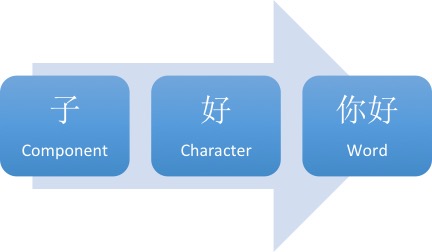
I like to think of Chinese like Lego . .. it's very “square”!
The individual bricks are the components (a.k.a radicals ).
We start to snap these components together to get something larger – the characters.
We can then snap characters together in order to make Chinese words.
Here's the really cool part about Chinese: Each of these pieces, at every level, has meaning.
The component, the character, the word… they all have meaning.
This is different to a European language, where the “pieces” used to make up words are letters.
Letters by themselves don't normally have meaning and when we start to clip letters together we are shaping a sound rather than connecting little pieces of meaning. This is a powerful difference that comes into play later when we are learning vocabulary.
Let's look at the diagram again.
Here we start with the component 子. This has the meaning of “child/infant”.
The character 好 (“good”) is the next level. Look on the right of the character and you'll see 子. We would say that 子 is a component of 好.
Now look at the full word 你好 (“Hello”). Notice that the 子 is still there.
- The character 好 is built of the components 女 and 子.
- The character 你 is built from 人 + 尔.
- The word 你好 in turn is constructed out of 你 + 好.
Here's the complete breakdown of that word in an easy-to-read diagram:
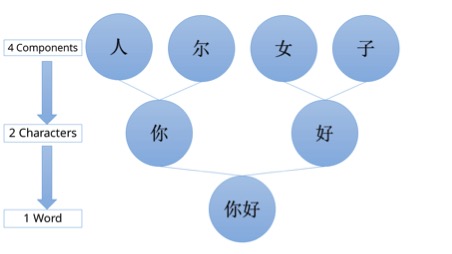
Now look at this photo of this in real life !
Don't worry if you can't understand it. Just look for some shapes that you have seen before.

The font is a little funky, so here are the typed characters: 好孩子
What components have you seen before?
Did you spot them?

This is a big deal.
Here's why…
Why Character Components Are So Important
One of the big “scare stories” around Chinese is that there are 50,000 characters to learn.
Now, this is true. But learning them isn't half as bad as you think.
Firstly, only a few thousand characters are in general everyday use so that number is a lot more manageable.
Second, and more importantly, those 50,000 characters are all made up of the same 214 components .
And you already know one of them: 子 (it's one of those 214 components).

The fact that you can now recognise the 子 in the image above is a huge step forward.
You can already recognise one of the 214 pieces all characters are made up of.
Even better is the fact that of these 214 components it's only the 50-100 most common you'll be running into again and again.
This makes Chinese characters a lot less scary.
Once you get a handle on these basic components, you'll quickly recognise all the smaller pieces and your eyes will stop glazing over!
This doesn't mean you'll necessarily know the meaning or how to pronounce the words yet (we'll get onto this shortly) but suddenly Chinese doesn't seem quite so alien any more.
Memorising The Components Of Chinese Characters
Memorising the pieces is not as important as simply realising that ALL of Chinese is constructed from these 214 pieces.
When I realised this, Chinese became a lot more manageable and I hope I've saved you some heartache by revealing this early in your learning process!
Here are some useful online resources for learning the components of Chinese characters:
- An extensive article about the 214 components of Chinese characters with a free printable PDF poster.
- Downloadable posters of all the components, characters and words.
- If you like flashcards, there's a great Anki deck here and a Memrise course here .
- Wikipedia also has a sweet sortable list here .
TAKEAWAY : Every single Chinese character is composed of just 214 “pieces”. Only 50-100 of these are commonly used. Learn these pieces first to learn how to write in Chinese quickly.
Moving From Components To Chinese Characters
Once you've got a grasp of the basic building blocks of Chinese it's time to start building some characters!
We used the character 好 (“good”) in the above example. 好 is a character composed of the components 女 (“woman”) and 子 (“child”).
Unlike the letters of the alphabet in English, these components have meaning .
(They also have pronunciation, but for the sake of simplicity we'll leave that aside for now!)
- 女 means “woman” and 子 means “child”.
- When they are put together, 女 and 子 become 好 …and the meaning is “good”.
- Therefore “woman” + “child” = “good” in Chinese 🙂
When learning how to write in Chinese characters you can take advantage of the fact that components have their own meanings.
In this case, it is relatively easy to make a mnemonic (memory aid) that links the idea of a woman with her baby as “good”.
Because Chinese is so structured, these kind of mnemonics are an incredibly powerful tool for memorisation.
Some characters, including 好, can also be easily represented graphically. ShaoLan's book Chineasy does a fantastic job of this.
Here's the image of 好 for instance – you can see the mother and child.

Visual graphics like these can really help in learning Chinese characters.
Unfortunately, only around 5% of the characters in Chinese are directly “visual” in this way. These characters tend to get the most attention because they look great when illustrated.
However, as you move beyond the concrete in the more abstract it becomes harder and harder to visually represent ideas.
Thankfully, the ancient Chinese had an ingenious solution, a solution that actually makes the language a lot more logical and simple than merely adding endless visual pictures.
Watch Me Write Chinese Characters
In the video below, which is part of a series on learning to write in Chinese , I talk about the process of actually writing out the characters. Not thousands of times like Chinese schoolchildren. But just as a way to reinforce my learning and attack learning Chinese characters from different angles.
My Chinese handwriting leaves a lot to be desired. But it's more about a process of reinforcing my language learning via muscle memory than perfecting my handwriting.
You'll also hear me discuss some related issues such as stroke order and typing in Chinese.
The Pronunciation Of Chinese Characters
The solution was the incredibly unsexy sounding… (wait for it…) “phono-semantic compound character”.
It's an awful name, so I'm going to call them “sound-meaning characters” for now!
This concept is the key to unlocking 95% of the Chinese characters.
A sound-meaning character has a component that tells us two things:
- the meaning
- a clue to how the character is pronounced
So, in simple terms:
95% of Chinese characters have a clue to the meaning of the character AND its pronunciation.
到 means “to arrive”.
This character is made of two components. On the left is 至 and on the right is 刀.
These are two of the 214 components that make up all characters. 至 means “to arrive” and 刀 means “knife”.
Any idea which one gives us the meaning? Yup – it's 至, “to arrive”! (That was an easy one 🙂 )
But how about the 刀? This is where it gets interesting.
到 is pronounced dào.
刀, “knife” is pronounced dāo.
The reason the 刀 is placed next to 至 in the character 到 is just to tell us how to pronounce the character! How cool is that?
Now, did you notice the little lines above the words: dào and dāo?
Those are the tone markers, and in this case they are both slightly different. These two characters have different tones so they are not exactly the same pronunciation.
However, the sound-meaning compound has got us 90% of the way to being able to pronounce the character, all because some awesome ancient Chinese scribe thought there should be a shortcut to help us remember the pronunciation!
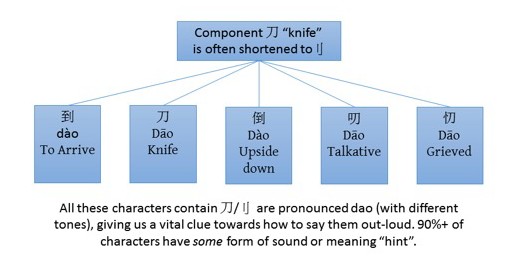
Let's look at a few more examples of how 刀 is used in different words to give you an idea of the pronunciation.
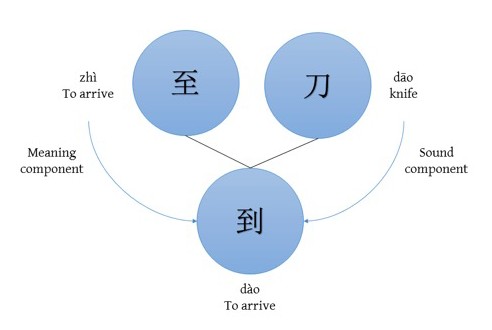
Even if sometimes:
- the sound-meaning character gives us the exact sound and meaning
- or it gets us in the ballpark
- or worse it is way off because the character has changed over the last 5,000 years!
Nevertheless, there's a clue about the pronunciation in 95% of all Chinese characters, which is a huge help for learning how to speak Chinese.
TAKEAWAY : Look at the component parts as a way to unlock the meaning and pronunciations of 95% of Chinese characters. In terms of “hacking” the language, this is the key to learning how to write in Chinese quickly.
From Chinese Characters To Chinese Words
First we went from components to characters.
Next, we are going from characters to words.
Although there are a lot of one-character words in Chinese, they tend to either be classically-rooted words like “king” and “horse” or grammatical particles and pronouns.
The vast majority of Chinese words contain two characters.
The step from characters to words is where, dare I say it, Chinese script gets easy!
Come on, you didn't think it would always be hard did you? 🙂
Unlike European languages Chinese's difficulty is very front-loaded.
When you first learn to write Chinese, you'll discover a foreign pronunciation system, a foreign tonal system and a very foreign writing system.
As an English speaker, you can normally have a good shot at pronouncing and reading words in other European languages, thanks to the shared alphabet.
Chinese, on the other hand, sucker-punches you on day one… but gets a little more gentle as you go along.
One you've realised these things:
- there aren't that many components to deal with
- all characters are made up of these basic components
- words are actually characters bolted together
…then it's a matter of just memorising a whole bunch of stuff!
That's not to say there isn't a lot of work involved, only to say that it's not particularly difficult. Time-consuming, yes. Difficult, no.
This is quite different from European languages, which start off easy, but quickly escalate in difficulty as you encounter complicated grammar, tenses, case endings, technical vocabulary and so on.
Making words from Chinese characters you already know is easy and really fun . This is where you get to start snapping the lego blocks together and build that Pirate Island!
The Logic Of Chinese Writing
Here are some wonderful examples of the simplicity and logic of Chinese using the character 车 which roughly translates as “vehicle”.
- Water + Vehicle = Waterwheel = 水 +车
- Wind + Vehicle = Windmill = 风+车
- Electric + Vehicle = Tram/Trolley = 电+车
- Fire + Vehicle = Train = 火+车
- Gas + Vehicle = Car = 汽+车
- Horse + Vehicle = Horse and cart/Trap and Pony = 马+车
- Up + Vehicle = Get into/onto a vehicle =上+车
- Down + Vehicle = Get out/off a vehicle =下+车
- Vehicle + Warehouse = Garage = 车+库
- To Stop + Vehicle = to park = 停+车
Chinese is extremely logical and consistent.
This is a set of building blocks that has evolved over 5,000 years in a relatively linear progression. And you can't exactly say the same about the English language!
Just think of the English words for the Chinese equivalences above:
Train, windmill, millwheel/waterwheel, tram/trolley, car/automobile, horse and cart/trap and pony.
Unlike Chinese where these concepts are all linked by 车 there's very little consistency in our vehicle/wheel related vocabulary, and no way to link these sets of related concepts via the word itself.
English is a diverse and rich language, but that comes with its drawbacks – a case-by-case spelling system that drives learners mad.
Chinese, on the other hand, is precise and logical, once you get over the initial “alienness”.
Making The Complex Simple
This logical way of constructing vocabulary is not limited to everyday words like “car” and “train”. It extends throughout the language.
To take an extreme example let's look at Jurassic Park .
The other day I watched Jurassic Park with my Chinese girlfriend. (OK, re -watched. It's a classic!)
Part of the fun for me (annoyance for her) was asking her the Chinese for various dinosaur species.
Take a second to look through these examples. You'll love the simplicity!
- T Rex 暴龙 = tyrant + dragon
- Tricerotops 三角恐龙 three + horn + dinosaur
- Diplodocus 梁龙 roof-beam + dragon
- Velociraptor 伶盗龙 clever + thief + dragon (or swift stealer dragon)
- Stegosaurus 剑龙 (double-edged) sword + dragon
- Dilophosaurus 双脊龙 double+spined+dragon
Don't try to memorise these characters, just appreciate the underlying logic of how the complex concepts are constructed .
(Unless, of course, you are a palaeontologist…or as the Chinese would say a Ancient + Life + Animal + Scientist!).
I couldn't spell half of these dinosaur names in English for this article. But once I knew how the construction of the Chinese word, typing in the right characters was simple.
Once you know a handful of characters, you can start to put together complete words, and knowing how to write in Chinese suddenly becomes a lot easier.
In a lot of cases you can take educated guesses at concepts and get them right by combining known characters into unknown words.
For more on this, check my series of Chinese character images that I publish on this page . They focus on Chinese words constructed from common characters, and help you understand more of the “building block” logic of Chinese.
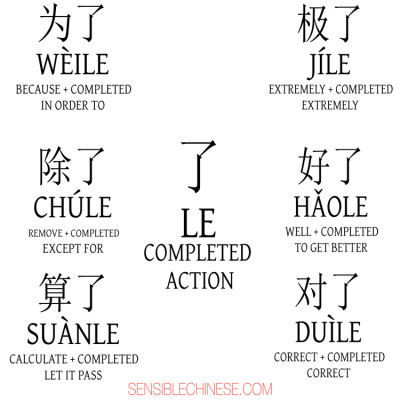
TAKEAWAY : Chinese words are constructed extremely logically from the underlying characters. This means that once you've learned a handful of characters vocabulary acquisition speeds up exponentially.
How To Learn Written Chinese Fast
Before diving into learning characters, make sure you have a decent grounding in Chinese pronunciation via the pinyin system.
The reason for this is that taking on pronunciation, tones and characters from day one is really tough.
Don't get me wrong, you can do it. Especially if you're highly motivated. But for most people there's a better way.
Learn a bit of spoken Chinese first.
With some spoken language under your belt, and an understanding of pronunciation and tones, starting to learn how to write in Chinese will seem a whole lot easier.
When you're ready, here's how to use all the information from this article and deal with written Chinese in a sensible way.
I've got a systematic approach to written Chinese which you can find in detail on Sensible Chinese .
Right now, I'm going to get you started with the basics.
The Sensible Character System
The four stages for learning Chinese characters are:
Sounds technical huh? Don't worry, it's not really.
This part of the process is about choosing what you put into your character learning system.
If you're working on the wrong material then you're wasting your efforts. Instead choose to learn Chinese characters that you are like to want to use in the future.
My list in order of priority contains:
- daily life: characters/words I've encountered through daily life
- textbooks: characters/words I've learnt from textbooks
- frequency lists: characters/words I've found in frequency lists of the most common characters and words
2. Processing
This is the “learning” part of the system.
You take a new word or character and break it down into its component parts. You can then use these components to create memory aids.
Hanzicraft.com or Pleco's built-in character decomposition tool are fantastic for breaking down new characters. These will be helpful until you learn to recognise the character components by sight. These tools will also show you if there are sound-meaning component clues in the character.
Use the individual components of a character to build a “story” around the character. Personal, sexy and violent stories tend to stick in the mind best! 🙂 I also like to add colours into my stories to represent the tones (1st tone Green, 2nd tone Blue etc.)
After the “input” and the “process”… it's time to review it all!
The simplest review system is paper flashcards which you periodically use to refresh your memory.
A more efficient method can be found in software or apps that use a Spaced Repetition System, like Anki or Pleco .
An important point: Review is not learning .
It's tempting to rely on software like Anki to drill in the vocabulary through brute-force repetition. But don't skip the first two parts – processing the character and creating a mnemonic are key parts of the process.
It isn't enough to just learn and review your words… you also need to put them into use !
Thankfully, technology has made this easier than ever. Finding a language exchange partner or a lesson with a cost-effective teacher is super simple nowadays, so there's no excuse for not putting your new vocabulary into action!
The resources I personally use are:
- Spoken – iTalki
- Written – Lang-8
- Short form written – WeChat / HelloTalk
Importantly, whilst you are using your current vocabulary in these forms of communication, you'll be picking up new content all the time, which you can add back into your system.
The four steps above are a cycle that you will continue to rotate through – all the corrections and new words you receive during usage should become material to add to the system.
To recap, the four steps of systematically learning Chinese characters are:
By building these steps into your regular study schedule you can steadily work through the thousands of Chinese characters and words you'll need to achieve literacy.
This is a long-haul process! So having a basic system in place is very important for consistency.
You can find out a lot more about The Sensible Chinese Character Learning System and how to write in Chinese here .
Top Chinese Learning Links And Resources
- Chinese Language Learning Resource List – a curated list of tools and content available online and in print to help your Chinese learning, all categorised by usage type.
- Sensible Character Learning System – the full system outlined in a series of blog articles for those who want more detail and tips on how to refine their character learning.
- 111 Mandarin Chinese resources you wish you knew – Olly’s huge list of the best resources on the web for learning Chinese
I hope you enjoyed this epic guide to learning how to write in Chinese!
Please share this post with any friends who are learning Chinese, then leave us a comment below!
Language Courses
- Language Blog
- Testimonials
- Meet Our Team
- Media & Press
Download this article as a FREE PDF ?
What is your current level in Swedish?
Perfect! You’ve now got access to my most effective [level] Swedish tips…
Where shall I send the tips and your PDF?
We will protect your data in accordance with our data policy.
What is your current level in Danish?
Perfect! You’ve now got access to my most effective [level] Danish tips…
NOT INTERESTED?
What can we do better? If I could make something to help you right now, w hat would it be?
Which language are you learning?
What is your current level in [language] ?
Perfect! You’ve now got access to my most effective [level] [language] tips, PLUS your free StoryLearning Kit…
Where shall I send them?
Download this article as a FREE PDF?
Great! Where shall I send my best online teaching tips and your PDF?
Download this article as a FREE PDF ?
What is your current level in Arabic?
Perfect! You’ve now got access to my most effective [level] Arabic tips…
FREE StoryLearning Kit!
Join my email newsletter and get FREE access to your StoryLearning Kit — discover how to learn languages through the power of story!
Download a FREE Story in Japanese!
Enter your email address below to get a FREE short story in Japanese and start learning Japanese quickly and naturally with my StoryLearning® method!
What is your current level in Japanese?
Perfect! You’ve now got access to the Japanese StoryLearning® Pack …
Where shall I send your download link?
Download Your FREE Natural Japanese Grammar Pack
Enter your email address below to get free access to my Natural Japanese Grammar Pack and learn to internalise Japanese grammar quickly and naturally through stories.
Perfect! You’ve now got access to the Natural Japanese Grammar Pack …
What is your current level in Portuguese?
Perfect! You’ve now got access to the Natural Portuguese Grammar Pack …
What is your current level in German?
Perfect! You’ve now got access to the Natural German Grammar Pack …
Train as an Online Language Teacher and Earn from Home
The next cohort of my Certificate of Online Language Teaching will open soon. Join the waiting list, and we’ll notify you as soon as enrolment is open!
Perfect! You’ve now got access to my most effective [level] Portuguese tips…
What is your current level in Turkish?
Perfect! You’ve now got access to my most effective [level] Turkish tips…
What is your current level in French?
Perfect! You’ve now got access to the French Vocab Power Pack …
What is your current level in Italian?
Perfect! You’ve now got access to the Italian Vocab Power Pack …
Perfect! You’ve now got access to the German Vocab Power Pack …
Perfect! You’ve now got access to the Japanese Vocab Power Pack …
Download Your FREE Japanese Vocab Power Pack
Enter your email address below to get free access to my Japanese Vocab Power Pack and learn essential Japanese words and phrases quickly and naturally. (ALL levels!)
Download Your FREE German Vocab Power Pack

Enter your email address below to get free access to my German Vocab Power Pack and learn essential German words and phrases quickly and naturally. (ALL levels!)
Download Your FREE Italian Vocab Power Pack
Enter your email address below to get free access to my Italian Vocab Power Pack and learn essential Italian words and phrases quickly and naturally. (ALL levels!)
Download Your FREE French Vocab Power Pack
Enter your email address below to get free access to my French Vocab Power Pack and learn essential French words and phrases quickly and naturally. (ALL levels!)
Perfect! You’ve now got access to the Portuguese StoryLearning® Pack …
What is your current level in Russian?
Perfect! You’ve now got access to the Natural Russian Grammar Pack …
Perfect! You’ve now got access to the Russian StoryLearning® Pack …
Perfect! You’ve now got access to the Italian StoryLearning® Pack …
Perfect! You’ve now got access to the Natural Italian Grammar Pack …
Perfect! You’ve now got access to the French StoryLearning® Pack …
Perfect! You’ve now got access to the Natural French Grammar Pack …
What is your current level in Spanish?
Perfect! You’ve now got access to the Spanish Vocab Power Pack …
Perfect! You’ve now got access to the Natural Spanish Grammar Pack …
Perfect! You’ve now got access to the Spanish StoryLearning® Pack …
Where shall I send them?
What is your current level in Korean?
Perfect! You’ve now got access to my most effective [level] Korean tips…
Perfect! You’ve now got access to my most effective [level] Russian tips…
Perfect! You’ve now got access to my most effective [level] Japanese tips…
What is your current level in Chinese?
Perfect! You’ve now got access to my most effective [level] Chinese tips…
Perfect! You’ve now got access to my most effective [level] Spanish tips…
Perfect! You’ve now got access to my most effective [level] Italian tips…
Perfect! You’ve now got access to my most effective [level] French tips…
Perfect! You’ve now got access to my most effective [level] German tips…
Download Your FREE Natural Portuguese Grammar Pack
Enter your email address below to get free access to my Natural Portuguese Grammar Pack and learn to internalise Portuguese grammar quickly and naturally through stories.
Download Your FREE Natural Russian Grammar Pack
Enter your email address below to get free access to my Natural Russian Grammar Pack and learn to internalise Russian grammar quickly and naturally through stories.
Download Your FREE Natural German Grammar Pack
Enter your email address below to get free access to my Natural German Grammar Pack and learn to internalise German grammar quickly and naturally through stories.
Download Your FREE Natural French Grammar Pack
Enter your email address below to get free access to my Natural French Grammar Pack and learn to internalise French grammar quickly and naturally through stories.
Download Your FREE Natural Italian Grammar Pack
Enter your email address below to get free access to my Natural Italian Grammar Pack and learn to internalise Italian grammar quickly and naturally through stories.
Download a FREE Story in Portuguese!

Enter your email address below to get a FREE short story in Brazilian Portuguese and start learning Portuguese quickly and naturally with my StoryLearning® method!
Download a FREE Story in Russian!
Enter your email address below to get a FREE short story in Russian and start learning Russian quickly and naturally with my StoryLearning® method!
Download a FREE Story in German!
Enter your email address below to get a FREE short story in German and start learning German quickly and naturally with my StoryLearning® method!
Perfect! You’ve now got access to the German StoryLearning® Pack …

Download a FREE Story in Italian!
Enter your email address below to get a FREE short story in Italian and start learning Italian quickly and naturally with my StoryLearning® method!
Download a FREE Story in French!

Enter your email address below to get a FREE short story in French and start learning French quickly and naturally with my StoryLearning® method!
Download a FREE Story in Spanish!
Enter your email address below to get a FREE short story in Spanish and start learning Spanish quickly and naturally with my StoryLearning® method!
FREE Download:
The rules of language learning.

Enter your email address below to get free access to my Rules of Language Learning and discover 25 “rules” to learn a new language quickly and naturally through stories.
What can we do better ? If I could make something to help you right now, w hat would it be?
What is your current level in [language]?
Perfect! You’ve now got access to my most effective [level] [language] tips…
Download Your FREE Spanish Vocab Power Pack

Enter your email address below to get free access to my Spanish Vocab Power Pack and learn essential Spanish words and phrases quickly and naturally. (ALL levels!)
Download Your FREE Natural Spanish Grammar Pack
Enter your email address below to get free access to my Natural Spanish Grammar Pack and learn to internalise Spanish grammar quickly and naturally through stories.
Free Step-By-Step Guide:
How to generate a full-time income from home with your English… even with ZERO previous teaching experience.
What is your current level in Thai?
Perfect! You’ve now got access to my most effective [level] Thai tips…
What is your current level in Cantonese?
Perfect! You’ve now got access to my most effective [level] Cantonese tips…
Steal My Method?
I’ve written some simple emails explaining the techniques I’ve used to learn 8 languages…
I want to be skipped!
I’m the lead capture, man!
Join 84,574 other language learners getting StoryLearning tips by email…
“After I started to use your ideas, I learn better, for longer, with more passion. Thanks for the life-change!” – Dallas Nesbit
Perfect! You’ve now got access to my most effective [level] [language] tips…
Perfect! You’ve now got access to my most effective [level] [language] tips…
Join 122,238 other language learners getting StoryLearning tips by email…
Find the perfect language course for you.
Looking for world-class training material to help you make a breakthrough in your language learning?
Click ‘start now’ and complete this short survey to find the perfect course for you!
Do you like the idea of learning through story?
Do you want…?
Tag: Essays
Essay: 《不死鸟》the immortal bird by sanmao.
- Post author By Kendra
- Post date March 25, 2023
- 4 Comments on Essay: 《不死鸟》The Immortal Bird by Sanmao
In this tear-jerker essay, famous Taiwanese authoress Sanmao ponders on the value of her own life. It was written as she grieved the drowning of her beloved Spanish husband in 1979, and is all the more tragic in light of her suicide 12 years later.
- Tags Essays
Essay:《爱》Love by Zhang Ailing (Eileen Chang)
- Post date June 12, 2020
- 5 Comments on Essay:《爱》Love by Zhang Ailing (Eileen Chang)
A tragic, dreamlike little essay from writer Zhang Ailing (张爱玲, English name Eileen Chang) about love and destiny. This is one of her more well-known works of micro-prose, written in 1944. HSK 5-6.
Essay:《打人》Hitting Someone by Zhang Ailing (Eileen Chang)
- Post date June 10, 2020
- 1 Comment on Essay:《打人》Hitting Someone by Zhang Ailing (Eileen Chang)
An essay from Chinese lit diva Zhang Ailing about a scene of police brutality she witnessed in Shanghai in the 1940s. HSK 6 and up.
Essay: 《感谢困难》Thanking Life’s Challenges by Lin Qingxuan
- Post date May 19, 2020
- 5 Comments on Essay: 《感谢困难》Thanking Life’s Challenges by Lin Qingxuan
You can skip your Instagram yoga gratitude break today, here’s another one from Taiwanese Buddhist essayist Lin Qingxuan (林清玄). HSK 4-5.
Essay: 《蝴蝶的种子》Seed of a Butterfly by Lin Qingxuan
- Post date May 7, 2020
- 2 Comments on Essay: 《蝴蝶的种子》Seed of a Butterfly by Lin Qingxuan
Taiwanese Buddhist essayist Lin Qingxuan marvels at the wonders of nature, time, space, and reincarnation. This piece is all about awe of the natural world, and you’ll learn some Discovery Channel vocab, like “pupa”, “mate”, “breed”, “spawn”, and lots of animal names.
- Tags Essays , Science
Letter: Ba Jin’s Correspondence with “Young Friends Searching for Ideals” – Part II
- Post date May 5, 2020
- 3 Comments on Letter: Ba Jin’s Correspondence with “Young Friends Searching for Ideals” – Part II
In Part II of this two-part series, we’ll read acclaimed author Ba Jin’s reply to the 10 elementary school students who wrote him a letter asking him for moral guidance in 1987. I’m not a super weepy person, but I legit cried reading this. This is a noble, elevating piece of writing, and reading it, I’m reminded that in all societies, there are those who struggle with the materialism that engulfs us.
Essay:《帮忙》 Helping Out
- Post date May 4, 2020
- 3 Comments on Essay:《帮忙》 Helping Out
In this one-paragraph read (HSK 2-3), Little Brother wants to help dad get ready to leave the house, but his contribution falls flat.
Essay: 《丑石》The Ugly Rock by Jia Pingwa
- Post date April 29, 2020
- No Comments on Essay: 《丑石》The Ugly Rock by Jia Pingwa
Jia Pingwa (贾平凹) is one of China’s modern literary greats, and in this short story, it shows. I don’t know how this guy crammed so many insights on the human condition into a few paragraphs about a rock, but he undeniably did.
Letter: Ba Jin’s Correspondence with “Young Friends Searching for Ideals” – Part I
- Post date April 27, 2020
- No Comments on Letter: Ba Jin’s Correspondence with “Young Friends Searching for Ideals” – Part I
In the first of a two-part post, we’ll look at a letter sent in 1987 from a group of elementary school students to the anarchist writer Ba Jin (most famous for his 1931 novel The Family) as they struggle to cope with China’s changing social values. In Part II, I’ll translate Ba Jin’s reply.
Essay: Desk-chairs of the Future
- Post date May 28, 2014
- 15 Comments on Essay: Desk-chairs of the Future
This kid was asked to imagine the perfect desk-chair of the future – what it would look like, and what it would do – and boy, does he ever. The chair turns into all kinds of utopian machinery. It flies, it helps you sleep, and it carries your books to school. Sentence structure is pretty […]
Essay: Catching Frogs
- Post date May 7, 2014
- 52 Comments on Essay: Catching Frogs
Though this post is beginner-level, it’s also very condensed. I’d say you’ll have to stop and remind yourself what something means every few words or so.
Essay: My First Telephone Call
- Post date June 11, 2013
- 24 Comments on Essay: My First Telephone Call
Though the conclusion of this essay might fall a bit flat for all of us who are very used to having a telephone, this is an interesting glimpse into what a monumental rite of passage it is for children in rural areas to have one or use one for the first time.
Essay: Papa, Please Don’t Smoke!
- Post date June 3, 2013
- 17 Comments on Essay: Papa, Please Don’t Smoke!
In this essay, a child desperately (and very angrily) pleads their father not to smoke. Though this is classified as “Intermediate”, beginners should definitely try this read, leaning heavily on the hover word-list. The difficult parts are the mid-level turns of phrase, which are all explained below.
Guest Post: The exam of life
- Post date May 6, 2013
- 26 Comments on Guest Post: The exam of life
Well well well, lookie here. A guest post! Today we’ll be reading Rebecca Chua’s (Chinese name: 蔡幸彤) translation of an essay from her textbook. The post is about the rewards of honesty. I remember my own textbook being full of these types of essays, so thank you, Rebecca, for the traditional read.
My Gluttonous Elder Brother
- Post date January 8, 2013
- 10 Comments on My Gluttonous Elder Brother
I set out to do a beginner post since I haven’t done one in a while, but no joy, I think I have to classify this as intermediate. Beginners are welcome to try this out, as most of the words are simple and the subject matter is a bit immature (so of course it totally […]
News: Snowstorm has caused 15 deaths and 2000 flight delays or cancellations
- Post date January 2, 2013
- 8 Comments on News: Snowstorm has caused 15 deaths and 2000 flight delays or cancellations
In the spirit of the holiday season, which is winding to a blissfully overweight close, I give you an article about something you may or may not have just struggled through if you flew home for the holidays (which I did).
Our Family’s Jump Rope Contest
- Post date October 2, 2012
- 17 Comments on Our Family’s Jump Rope Contest
A single-paragraph essay about the results of a family jump rope competition.
After I Got My New Years’ Money
- Post date September 10, 2012
- 20 Comments on After I Got My New Years’ Money
For those of you new to Chinese culture, one thing a Chinese child most looks forward to all year is the time during Spring Festival (Chinese New Year) when they get to go ask their neighbors and other adults for red envelopes containing some money – it’s a bit like trick-or-treating for cash. This essay […]
Essay: A Foolish Affair from my Childhood
- Post date August 29, 2012
- 20 Comments on Essay: A Foolish Affair from my Childhood
This essay is about a kid who takes his father’s advice a little too literally (with amusing results).
Dear Diary: Mama Please Believe Me
- Post date May 3, 2012
- 18 Comments on Dear Diary: Mama Please Believe Me
And now a break from all the intermediate and advanced exercises I’ve been posting lately. This one is a straightforward beginner Chinese diary-style essay about a student whose mother is displeased with his (or her, it’s never clarified) homework.
Hacking Chinese
A better way of learning mandarin, 36 samples of chinese handwriting from students and native speakers.
Unlike most other languages, handwriting in Chinese can be regarded as a separate skill. Learning to write by hand is not easy; learning to write well is even harder. In an earlier article, I discussed handwriting in details, including how to improve it as a student.
How to improve your handwriting in Chinese
I have collected more than thirty examples of handwriting in Chinese, most of them from students of different ages from various countries across the world. I also gather some examples from native speakers to show as a reference.
The examples below are presented roughly in the order of time spent learning the language, with beginners at the start and native speakers at the very end. Counting study time in years can be very misleading , but since there is no better way of sorting the samples, I chose to do that anyway.
The purpose of this article is not to make a systematic study of student handwriting, although that would be interesting. Apart from time spent learning, another important factor is what the student’s writing looks like in her native language. I have seen enough student handwriting to feel confident when I say that there’s a lot of positive transfer going on, so someone who writes neatly in their native language are likely to write neatly in Chinese too. Beginners of this kind might write neatly but with incorrect strokes and so on, but penmanship still carries over to learning Chinese.
Speaking of penmanship, it should be mentioned that there is probably a strong selection bias at work here. While not all who submitted their handwriting write well, I think it’s safe to assume that people who like handwriting are more likely to have submitted photos of their handwriting when I asked for it. In other words, the average student probably writes worse than the below photos show.
Chinese handwriting from 36 people, using exactly the same tex
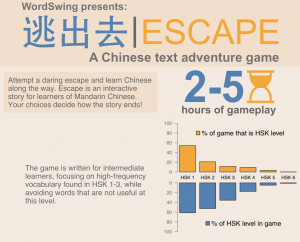
Escape: A text adventure game for Chinese learners
Simplified Chinese:
你被关在一个小房间里。你并不记得发生了什么,也不知道为什么被关在这里。你以前从房门的窗口那儿得到食物,但是你用力敲门或者大叫都没有用。你决定一定要逃跑,要不然情况可能会变更不好。
Traditional Chinese:
你被關在一個小房間裡。你並不記得發生了什麼,也不知道為什麼被關在這裡。你以前從房門的窗口那兒得到食物,但是你用力敲門或者大叫都沒有用。你決定一定要逃跑,要不然情況可能會變更不好。
A big thank you to everyone who contributed!
Chinese handwriting after a year of studying (or less)
The first submission comes from the US, and also include some information about the student. I collected some submissions years ago, so “since the beginning of 2016” actually means less than a year of studying!
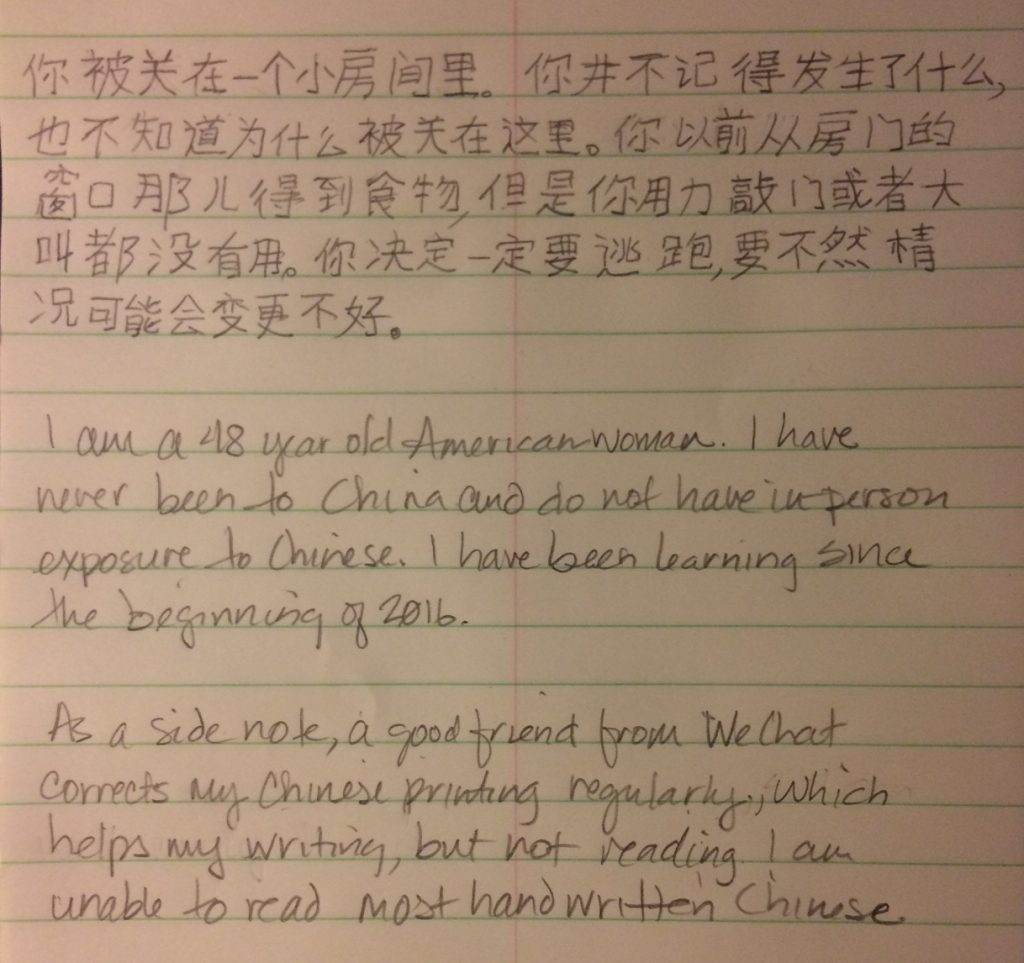
August from Suriname submitted the below sample. He’s 71 and has studied Chinese for one year.
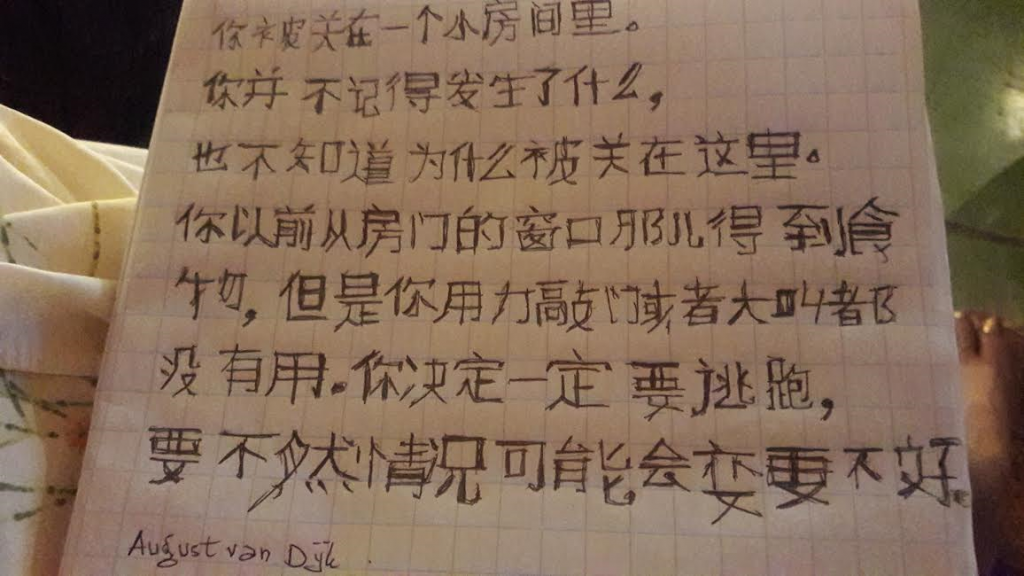
Thomas Walker on Twitter writes: “Here is my effort. Been studying Chinese for about 8 months. Your site has been a massive help, keep up the good work!”
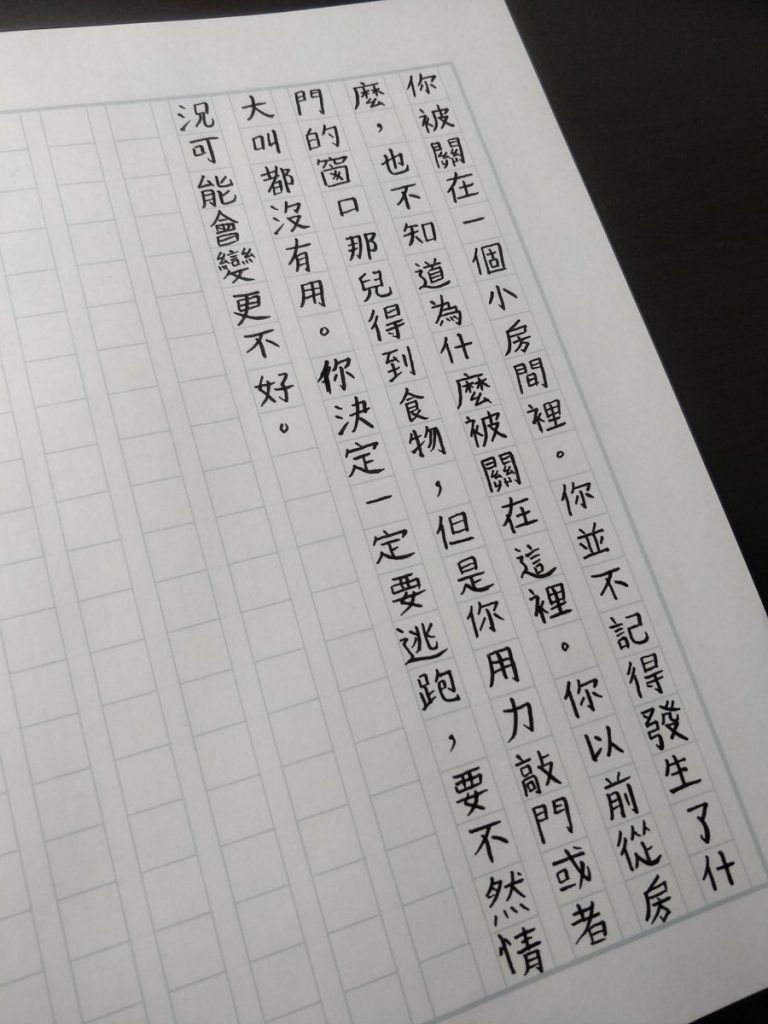
Chinese handwriting after studying between one and five years
A student from the US sent in the below photo of his handwriting, saying that he’s 51 years old and has been learning Chinese for a little more than one year.

This is from a 22-year-old Belgian student. She has been studying Chinese for little more than a year:
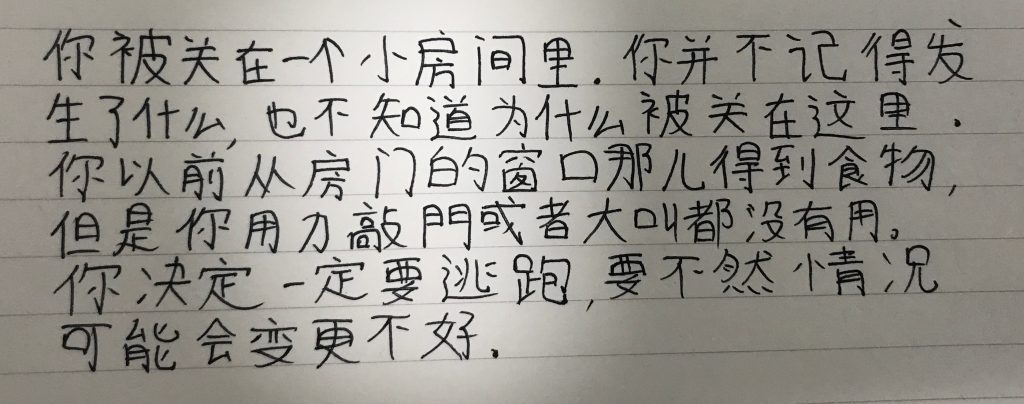
The next submission is from a 27-year-old Bulgarian student who has studied Chinese for three semesters in Wuhan:

From @fenma on Twtitter : “two years, self, no class, no visit, HSK3”:
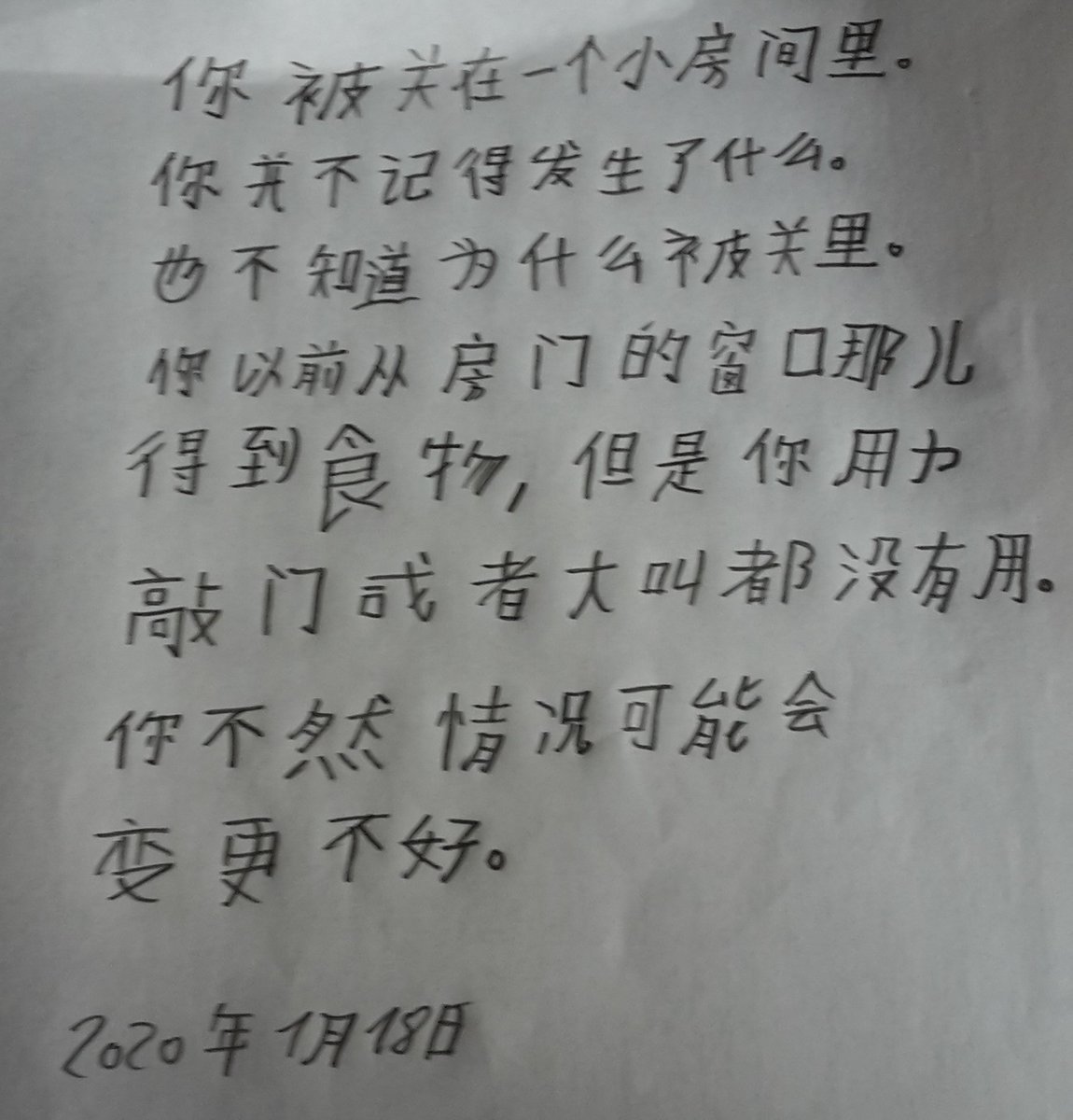
A student from France submitted the following sample, saying “I’m around HSK3, with two years living in China where I self practiced writing despite everybody telling me it’s useless (it’s not; it was super useful every single day, whether teaching my Chinese pupils or writing some unknown OCR resistant character in the street in Pleco). I would practice every day with a cheap calligraphy marker (to force myself to write slowly and purposefully; the difference with using a pen/pencil is like night and day, for learning purposes) in a 10RMB kids hanzi practice book bought in Carrefour and I could totally feel the difference very quickly. I used a pen and wrote as fast as I could to give you something a bit more realistic.”
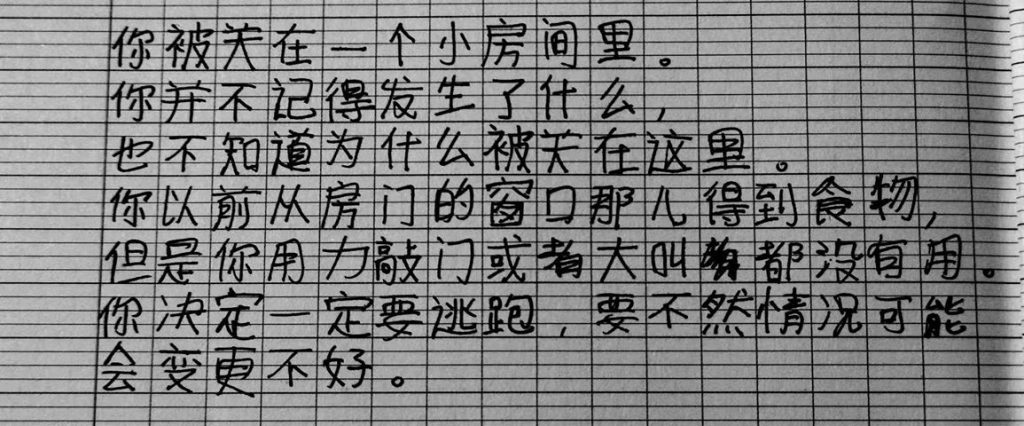
Next is a sample from a Peruvian student. She’s 24 and has studied Chinese for roughly three years:

The last sample in this category comes from 35-year-old Norwegian, who has studied four years of Chinese, mostly self-studying:

Chinese handwriting after having studied for five to ten years
Dr. Chuck on Twitter writes: “I haven’t tried learning how to speak it yet, but I’ve studied the traditional writing for fun in my spare time over the past 5 years. My closet is a graveyard of graph paper!”

Joey on Twitter writes: “I’ve been studying for a little over 5 years now. Hope this helps!”

MissFitti on Twitter writes: “I have been learning Mandarin for my BA and MA in Italy and I am now teaching it at Secondary in England. 5 years at uni in total, and lived in china for 1 year and 6 months :)”
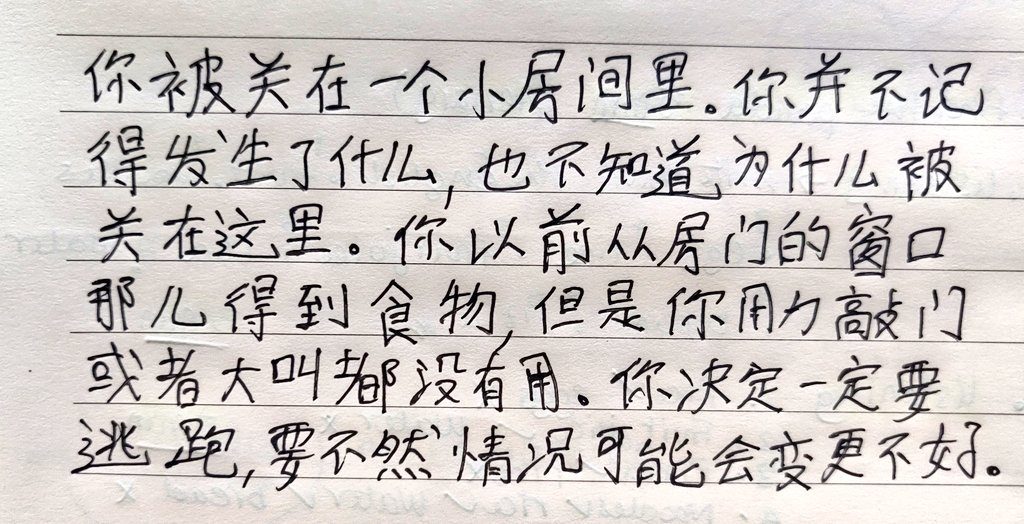
A student from Scotland sent me the below sample of his handwriting. He says he’s been working in China for over five years, and have studied Chinese, but had very little teaching on how to write characters. Just like the rest of us, he mainly uses phones and computer for writing Chinese:
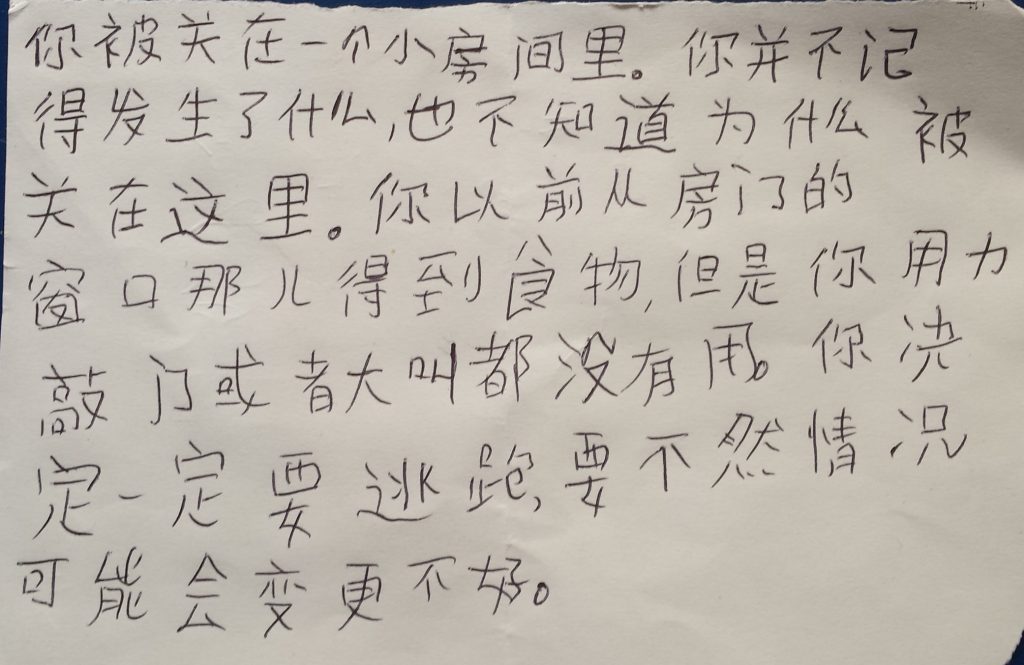
A student from the US submitted the below photo with this comment: “I have been studying, and I use the word studying loosely, Chinese for about 5-6 years. […] My reading skills far outweigh my listing, speaking, and as you can see from my attached text, writing skills. […] Thanks for all you do. I truly appreciate you.”
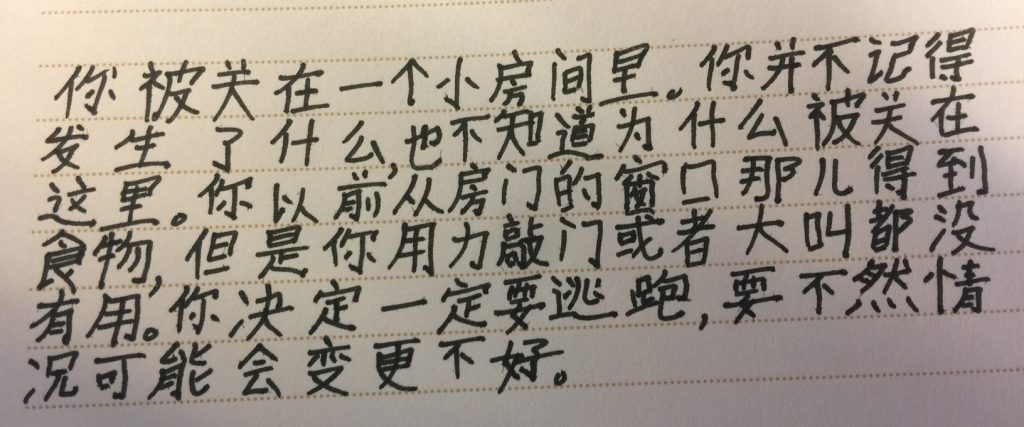
Brandon Rivington on Twitter writes: “I tried to make it as natural as possible. I’ve been studying Chinese for about 7 years. I look forward to reading the article!”
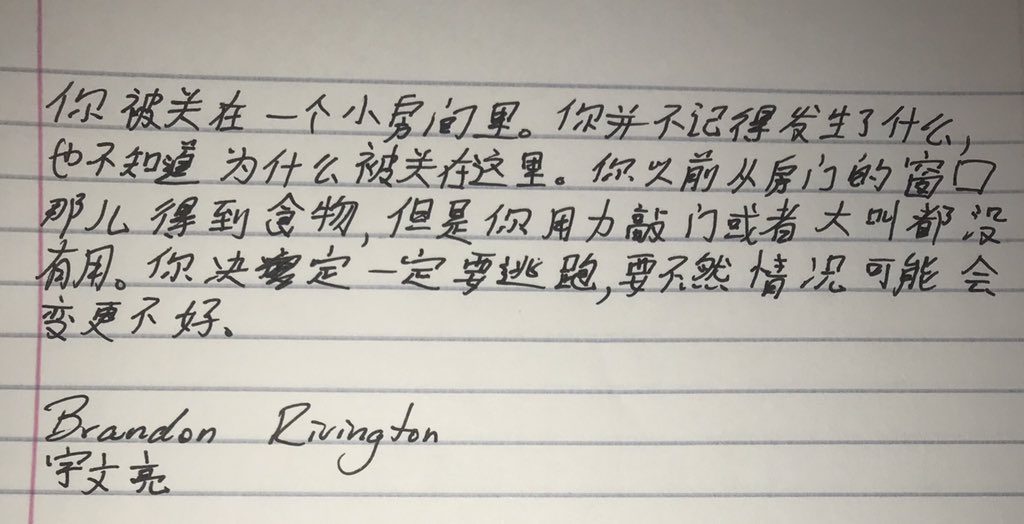
The next sample comes from a 36-year-old student from Spain, who has learnt Chinese for about nine years:
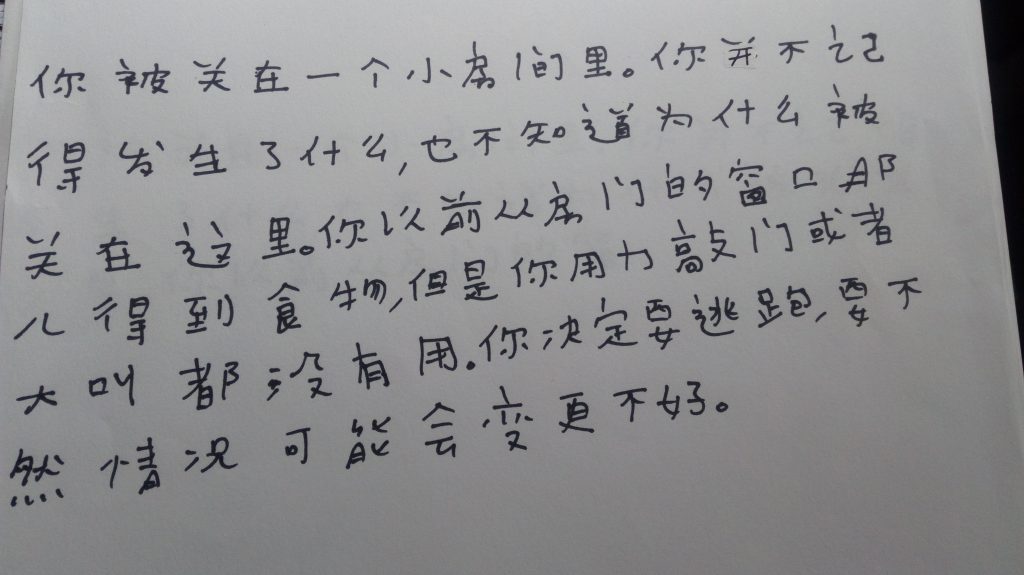
And another submission from Spain, from someone who is two years younger, but has also studied for about nine years:
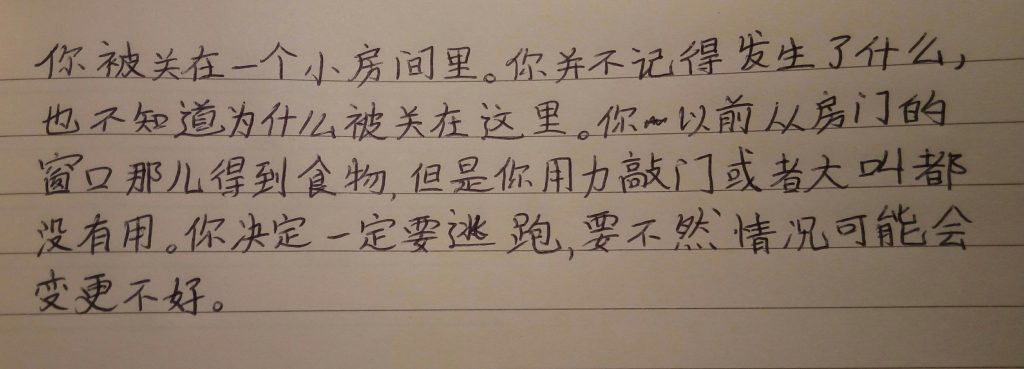
A Polish student submitted the below photo of his handwriting and said: “I’m 24 years old and I’ve been learning Chinese for about 9 years. 3 years ago I passed HSK5 and I’m planning to pass HSK6 the next year.”

Chinese handwriting after studying for ten years or more
Anna K. on Twitter writes: “Studied Chinese 10+ years, taught it one year. Thanks for your excellent blog and work!”
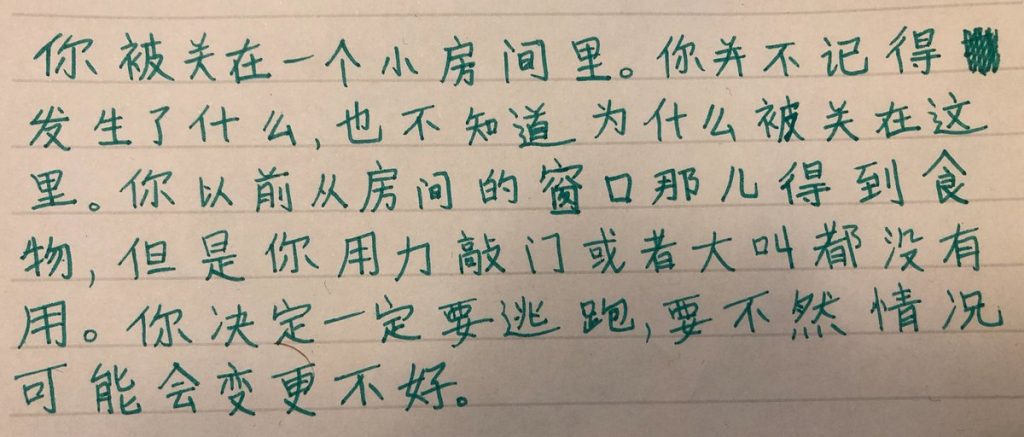
Here’s a submission from Melbourne, Australia (information included). She has been learning for 12 years.
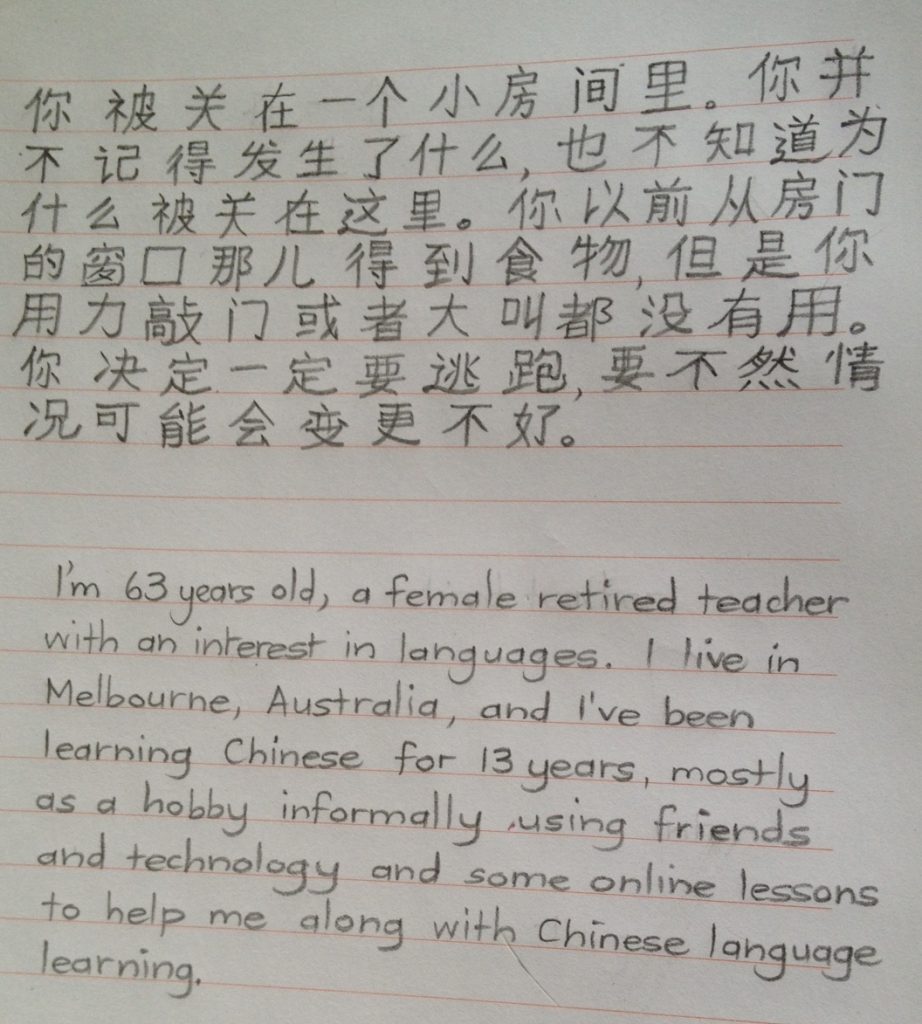
TranslationRaven writes on Twitter: “Studied Chinese for 12 years in school, didn’t read or write for 8 years after that. Returned to Asia and got my teaching diploma in Chinese after those 8 years. Not sure how I’d categorize myself, haha”
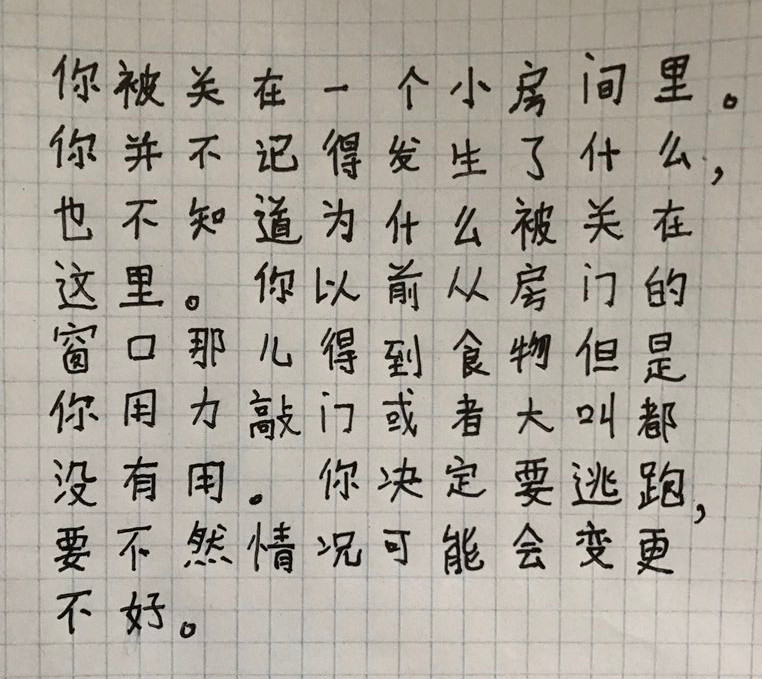
Miriam from Germany submitted the below sample:

David Hull 胡大衛 on Twitter writes: “Always been very self-conscious about my sloppy handwriting. Picked up Chinese late- in my mid 20s. Studied in PRC and US. I haven’t been writing by hand for years (except on the blackboard). I’m an asst Prof of Chinese now. Started in the army program at the Defense Language Institute in ’96 (we didn’t do much writing at all). I didn’t have a chance to formally study again until ’01, and by then it was almost all typed.”
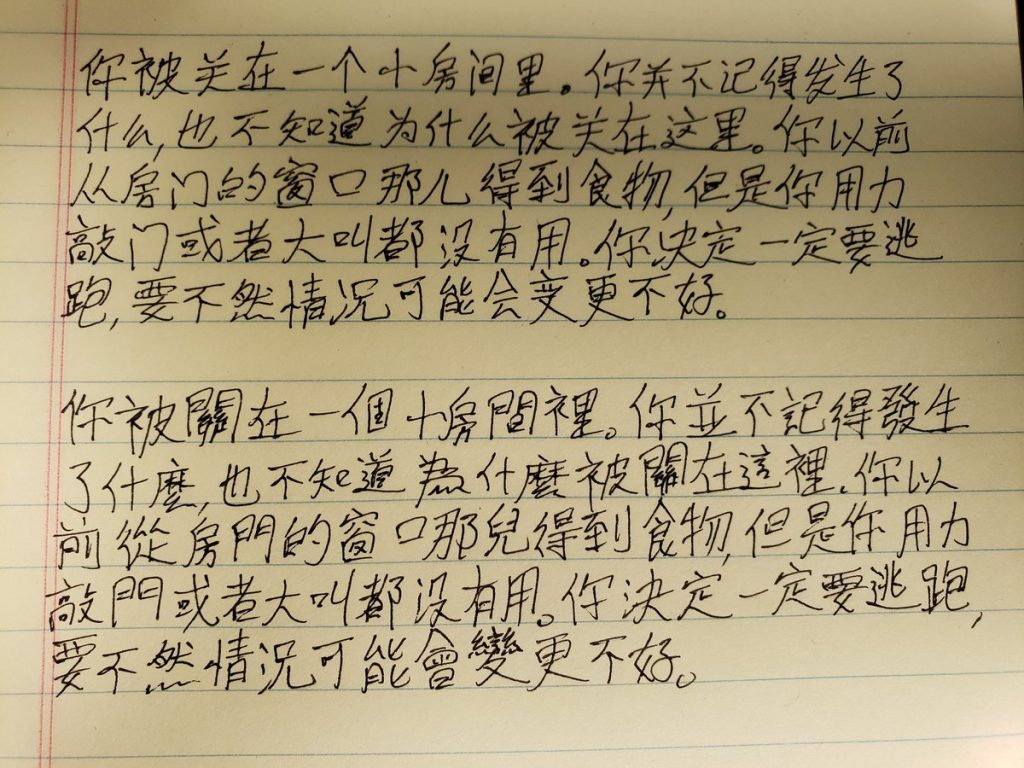
The last sample in this category comes from the US. She has 26 years of formal and informal studying behind her:
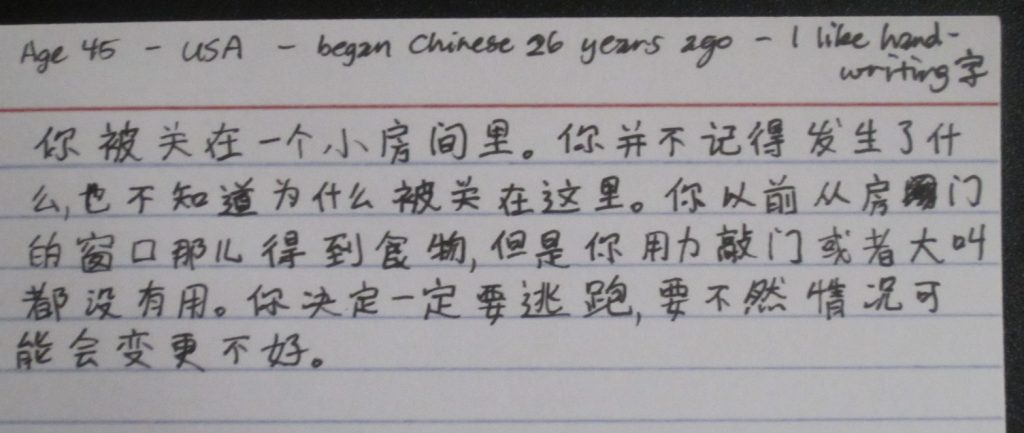
Chinese handwriting from native speakers
Now, let’s move on to native speakers. For people who find some of these difficult to read, please check this article for some advice on how to proceed: Learning to read handwritten Chinese
Learning to read handwritten Chinese
A student, who grew up speaking Chinese with her mother and took a few years of Chinese in school, but then forgot most about it, sent in the following sample. She also writes that “this may be the most I’ve ever written by hand, I do everything digitally now, I practice my writing skills by writing to my mother on my cellphone.”

Vicky Lee on Twitter writes: “I am a little bit shamed to write the Chinese like this? It is only recognizable but far from being beautiful.”
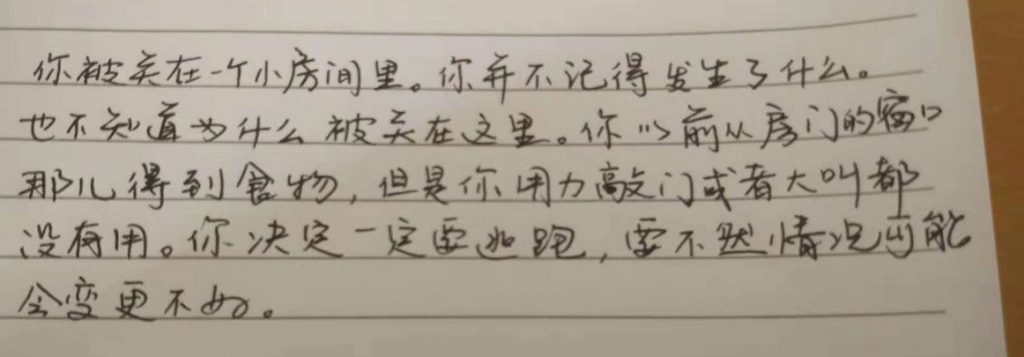
Female native speaker, 30 years old:
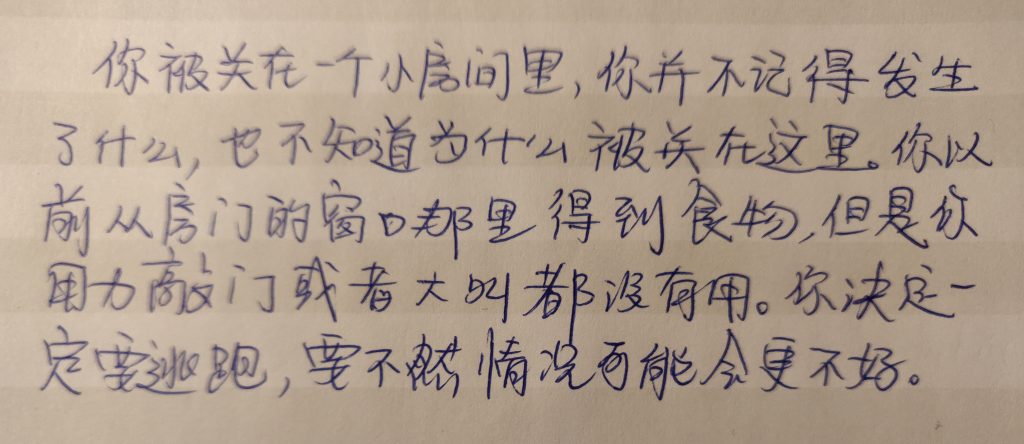
This is from a 22-year-old native speaker (male):

A native speaker from China, submitted this through Facebook Age ~50. “You are very appreciated to promote Chinese culture.”
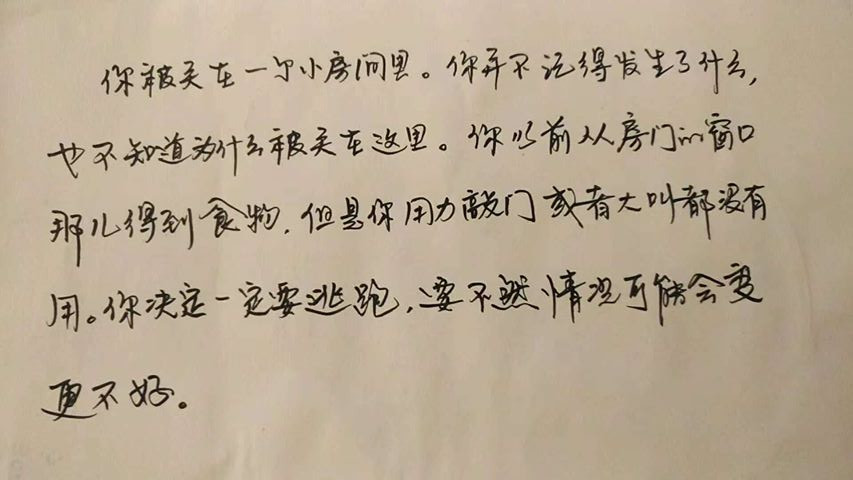
A native speaker who grew up in Malaysia, now in her fifties:

And another native speaker from Beijing (male, around 50):

Here’s another native speaker who teaches English near Shanghai (age unknown):
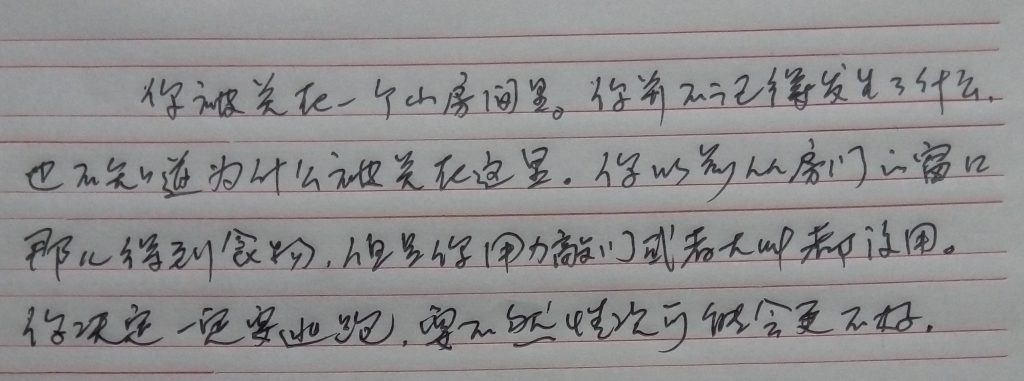
Native speaker, female, age around 50:

Native speaker, age unknown:

And an extra submission, provided after the article was published, so actually number 37: “Age 28, live in China mainland, written by Lamy Safari”, originally posted here .
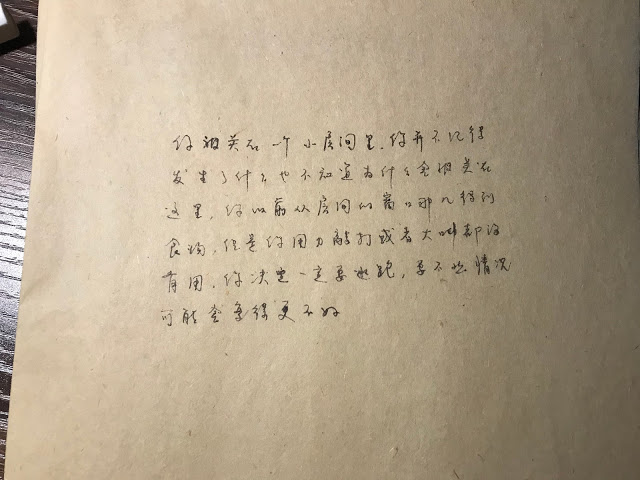
Conclusion: Chinese handwriting in the 21st century
I’m not sure if any conclusion can be drawn from the samples shown above; that wasn’t really the intention. If you have some thoughts you want to share after checking them out, please leave a comment!
How good your handwriting is depends on many things, including how good your penmanship is in your native language. Time spent practising and how much you care are two other important factors. If you don’t think your handwriting is very good because you haven’t practised enough, that’s nothing to be ashamed of. In this electronic era, writing neatly by hand is not an essential skill for most students.
For those of you who want to improve your handwriting, I conclude here by linking to the previous article :
https://www.hackingchinese.com/how-to-improve-your-chinese-handwriting/

16 comments
The actor 黄轩 posts poems handwritten by his fans on 微博 the blog is called 瞬间MomentX, I find handwritten notes or artistic shop signs very difficult to read
This is fascinating! Thank you so much for this compilation. There’s something very touching about seeing hand-written notes, it’s hard to explain.
Most of the learners’ notes are easy to read, but on the other hand some of the natives’ notes are hard to decipher for the non-native eye. It can’t only be a question of speed, surely…
Thomas Walker is by far the best, in my opinion.
I totally agree. I would be interested to learn his methods. Pen thickness seems to be a major factor. Depending on the day, I can write well with a 0.4mm pen, other days, I need a 0.7mm one.
Thomas Walker’s is awesome – but the Australian teacher lady is really impressive, too (and she’s not working on handwriting grid paper.) Her English handwriting looks exactly like a teacher – she’s obviously used to being very tidy in her writing.
Maybe their chinese handwriting is correlated to their english handwriting. They seem to have similar style.
Yes, that’s a good point. I realised too late that I should have asked people to write the same passage in English as well.
Native here. Yes, our Chinese handwriting and English handwriting (that is, for those of us who can write English) pretty much correlates to each other in style
Age 28, live in China mainland, written by Lamy Safari:
https://igonejack.blogspot.com/2020/01/sample-of-chinese-handwriting.html
Thank you for your submission! I added your writing to the article and I will also mention it on social media, including a link to your page.
Hi, I’m studying in the UK and I have a few people I know from China. I’ve seen what they write a couple of times … it’s some kind of horror. I mean that it is very difficult, I do not envy them. Recently, I read an essay about stereotypes, and still, I will say that they are so true. People who have studied Chinese, tell me how long you have been learning this beautiful language, how long you have been learning to write in Chinese because as far as I understand, one wrong dash and you are writing about something completely different. This is tin, the most difficult language.
Learning to read and write Chinese characters certainly takes a long time, probably longer than learning any other written language. However, we don’t have to exaggerate the difficulty. A misplaced stroke will almost never influence the comprehensibility of what you write. There are specific cases where certain characters differ only in one stroke (position, length, relationship to other strokes), but these aren’t very common, and in context, it’s practically never an issue. That doesn’t make the writing system easy to learn, but it’s not impossible!
As a native Chinese/Cantonese speaker, I can conclude that people who learn Chinese writes better than natives haha
The range of handwriting among the two groups certainly overlaps! I think this is because penmanship is a completely different skill from other aspects of writing (such as composition). I have had beginner student of Chinese who write very good-looking characters from day one, although of course they still struggle with things that require knowledge of characters, such as how long certain strokes should be, which strokes should touch or cross certain other strokes and so on.
These all say the exact same thing, and it doesn’t make sense, or seems like a crazy person wrote it. If you’re going to scam people, put more effort into it.
I’m afraid I don’t understand your comment. They’re all the same because I asked people to write a specific passage; the first subheading even says “Chinese handwriting from 36 people, using exactly the same tex”, so what did you expect? The whole point is to use the same text so people can compare how different people write the same thing. Also, what scam?
Leave a comment Cancel reply
Your email address will not be published. Required fields are marked *
This site uses Akismet to reduce spam. Learn how your comment data is processed .
Privacy Overview
- Sign In Sign Up
- / AI Writer Language
Write in Chinese
Write in Chinese with the AI Writer
30+ Languages
Write in Chinese or Translate
Short and Long-Form Copy
Free Forever AI Writer

The Best AI Templates for Chinese Content
Simplified's AI Writer has over 50 writing templates you can generate content with in over 30 global languages. Use the free Short Form Assistant to generate product descriptions, company bios, blog titles, ads, and more. Upgrade to write entire articles, blogs, books, and press releases in Chinese with the Long Form Writer Free Flow. It's never been simpler!
In your open AI project, select your 'Output Language' from the dropdown menu.
Fill in the prompts in any language - the same as the chosen for the output, or any other.
Then, click 'Generate'.
Check the options provided by AI, choose a result, and use it in your project.

Boost Traffic with High-Quality Chinese Content
Write mistake-free, human-like content that reaches bigger audiences in dozens of countries. Convert more customers with copy that speaks to them in their own language. Our unique copy AI is trained to generate trending hashtags and SEO-focused captions, blogs, and emails in Chinese, and more. Save 1 hour each day with AI!
Do More, Learn More With Simplified

Generate Entire Blogs, Long Articles, and Essays in Minutes with AI Long Form Writer

Best Free Long-Form AI Writer Copy Generator

Simplified's AI Short Form Assistant

How to Write a Blog in Less Than 30 Minutes Using AI
Discover More
Frequently asked questions, where can i access copy ai templates.
Right here! When you log into the free Simplified website (you heard that right... free), head on over to the AI Writer. Select the Short Form Assistant, choose the template you prefer as well as your output language, and you're off to the races!
Who is the AI content writer for?
What can simplified's ai write for you, can i use the ai writer with a free account, what is your refund policy, keep your creative flow going in any language.
Write Original, Relevant Copywriting with the Best AI Writer
What our 10 million+ users are saying about Simplified
Aggregate review rating.
Date - May 7, 2023
Revolutionize your content creation with Simplified
What I love about Simplified is that it's super easy to use. All you have to do is choose your output language and tone, complete the prompt, and click 'Generate.' It'll then give you several options to choose from, and you can pick the one that suits your needs best.
Date - Feb 24, 2023
Excellent writer, cuts down on working hours
High-quality AI writer, and it is excellent that it is free. I love to type, but in these cold winters, my hands start to freeze up and become stiff. Having an AI writer lets me keep my brain occupied with work tasks, without having to get the creative writing part of my brain involved.

Date - Jan 04, 2023
Easy to use & consistently quality AI writer!
While Simplified has many other features besides its AI writer which I hope to explore in the future, as the owner of multiple health websites, I love how it handles writing technical and health content with ease.

Date - May 2, 2023
New to writting a Blog
I reviewed several AI content writers and settled on Simplified. What I like best is it is so easy to use and yet gives you so many customizable options. It is sooooo quick and easy for beginners I would highly recommend it!

Date - Feb 13, 2023
Mind Blowing Powerful AI assistant
Simplified is now an essential writing tool in my life. Better than ChatGPT which is already mind blowing in and of itself so that is saying a lot.

Date - Mar 10, 2023
I loved the communication. AI including the diverse amount of options for generating!
Simplified allows anyone from a simple to an expert user of the AI—whether a beginner or expert writer—to use precise commands, prompts, context and lists to "communicate" with the said software to generate well-organised text that fits into whatever you form it to.
Made with ❤️ remotely by TLDR Technologies, Inc
© 2024, All Rights Reserved, TLDR Technologies, Inc
Introduce Yourself in Chinese with Self-Introduction Speech Examples
How to introduce yourself in chinese.
It is not difficult to introduce yourself in Chinese language as they are fixed answers which you memorise about yourself. However, it is not that easy to be able to understand all the variations of questions asked. Therefore, in this article, you will also learn about various ways of questioning and response, so you know they mean the same thing and handle the Chinese self-introduction with ease.
For a start, I have prepared three articles below with audio on self-introduction speech examples, changing the variation of replies in Chinese for beginners when you introduce yourself in Mandarin. The questions and answers will revolve around: –
① Chinese Greetings and Pronouns ② Your Name and Surname ③ Your Age ④ Your Country and Nationality ⑤ Your Hobby and Interest ⑥ Your Relationship and Marital Status
It is always a good practice to read and listen in Mandarin to guess the meaning of the articles before looking at the English translation.
Chinese Self-Introduction Essay and Speech Samples
你们好! 我叫芮。 其实,芮是我的姓氏。我是华人。我来自新加坡。不过,我现在居住安特卫普,比利时的一个美丽城市。我有一个英俊的比利时男友。我会说英语、华语、广东话、法语和荷兰语。现在,我和你们一样,都在学习语言。我每天要去学校上荷兰语课。
平时,在业余时间,我写博客和上网查询资料。在周末,我喜欢和我的男朋友一起骑自行车,拍照,购物和吃饭。 我最喜欢去餐馆吃中餐。我的最爱是旅行。我去过很多国家。
那你呢?请你自我介绍,告诉我平时你喜欢做些什么?请留言。
Hāi! Dú zhě men,
Nǐ men hǎo! Wǒ jiào Ruì. Qí shí, Ruì shì wǒ de xìng shì. Wǒ shì huá rén. Wǒ lái zì xīn jiā pō. Bù guò, wǒ xiàn zài jū zhù ān tè wèi pǔ, bǐ lì shí de yī gè měi lì chéng shì. Wǒ yǒu yīgè yīng jùn de bǐ lì shí nán yǒu. Wǒ huì shuō yīng yǔ, huá yǔ, guǎng dōng huà, fǎ yǔ hé hé lán yǔ. Xiàn zài, wǒ hé nǐ men yī yàng, dōu zài xué xí yǔ yán. Wǒ měi tiān yào qù xué xiào shàng hé lán yǔ kè.
Píng shí, zài yè yú shí jiān, wǒ xiě bó kè hé shàng wǎng chá xún zī liào. Zài zhōu mò, wǒ xǐ huān hé wǒ de nán péng yǒu yī qǐ qí zì xíng chē, pāi zhào, gòu wù hé chī fàn. Wǒ zuì xǐ huān qù cān guǎn chī zhōng cān. Wǒ de zuì ài shì lǚ xíng. Wǒ qù guò hěn duō guó jiā.
Nà nǐ ne? Qǐng nǐ zì wǒ jiè shào, gào sù wǒ píng shí nǐ xǐ huān zuò xiē shén me? Qǐng liú yán.
Hi Readers,
How are you? I am called Rui. In fact, Rui is my surname. I am a Chinese. I come from Singapore. However, I am now living in Antwerp, a beautiful city in Belgium. I have a handsome Belgian boyfriend. I can speak English, Mandarin, Cantonese, French, and Dutch.
Now, I am like you, learning a language too. Every day, I go to school for my Dutch class. Usually, during my spare time, I blog and surf the internet for information. During the weekend, I like to cycle with my boyfriend, take photographs, shopping and eating. I also like going to restaurants to eat Chinese food. My favourite is travelling. I have been to many countries.
How about you? Please introduce yourself. Tell me what do you usually like to do? Please leave a message.
我的名字是彼得。 我今年27岁。 我从美国来的。 我还单身,也没有女朋友。 我会说英语和一点点西班牙语。我也在学习汉语。可是,我的中文说的不太好,还可以在进步。
我想去中国旅行。我对中国的文化和语言很感兴趣。我希望找一位中国女友。我可以向她学习中文。我也能教她英语。我很好动。平时,我喜欢做运动, 例如跑步和游泳。
Hāi! Nín hǎo!
Wǒ de míng zì shì Bǐ Dé. Wǒ jīn nián 27 suì. Wǒ cóng měi guó lái de. Wǒ hái dān shēn, yě méi yǒu nǚ péng yǒu. Wǒ huì shuō yīng yǔ hé yī diǎn diǎn xī bān yá yǔ. Wǒ yě zài xué xí hàn yǔ. Kěs hì, wǒ de zhōng wén shuō de bù tài hǎo, hái kěyǐ zài jìn bù.
Wǒ xiǎng qù zhōng guó lǚ xíng. Wǒ duì zhōng guó de wén huà hé yǔ yán hěn gǎn xìng qù. Wǒ xī wàng zhǎo yī wèi zhōng guó nǚ yǒu. Wǒ kě yǐ xiàng tā xué xí zhōng wén. Wǒ yě néng jiào tā yīngyǔ. Wǒ hěn hào dòng. Píng shí, wǒ xǐ huān zuò yùn dòng, lì rú pǎo bù hé yóu yǒng.
My name is Peter. I am 27 years old this year. I come from the United States. I am still single and also do not have a girlfriend. I speak English and some Spanish. Now, I am also learning Chinese. However, I do not speak Mandarin so well. It can still be improved.
I wish to travel to China. I am very interested in Chinese culture and language. I hope to find a Chinese girlfriend. I can learn Chinese from her. I can teach her English. I am very active. Usually, I like to exercise such as jogging and swimming.
我是爱丽丝。大家都叫我丝丝。我是加拿大人。十年前,我从加拿大搬迁到台湾工作。我学了五年的中文,现在能说一口流利的华语。我现年四十岁。 我已婚,嫁给了一位台湾人。我有两个孩子,一个儿子和一个女儿。
我的嗜好是烹饪、阅读、听音乐和教书。我是一名教师。 我会说流利的英语、华语、 法语和一点点葡萄牙语。我不太喜欢做运动。不过,我很喜欢旅行,到处走走。
Hāi! Nǐ hǎo!
Wǒ shì Ài Lì Sī. Dà jiā dōu jiào wǒ Sī Sī. Wǒ shì jiā ná dà rén. Shí nián qián, wǒ cóng jiā ná dà bān qiān dào tái wān gōng zuò. Wǒ xué le wǔ nián de zhōng wén, xiàn zài néng shuō yī kǒu liú lì de huá yǔ. Wǒ xiàn nián sì shí suì. Wǒ yǐ hūn, jià gěi le yī wèi tái wān rén. Wǒ yǒu liǎng gè há izi, yīgè er zi hé yī gè nǚ’ér.
Wǒ de shì hào shì pēng rèn, yuè dú, tīng yīn yuè hé jiāo shū. Wǒ shì yī míng jiào shī. Wǒ huì shuō liú lì de yīng yǔ, huá yǔ, fǎ yǔ hé yī diǎn diǎn pú táo yá yǔ. Wǒ bù tài xǐ huān zuò yùn dòng. Bù guò, wǒ hěn xǐ huān lǚ xíng, dào chù zǒu zǒu.
Hello, my name is Alice. Everyone call me Si Si. I’m a Canadian. Ten years ago, I relocated from Canada to work in Taiwan. I have studied Chinese for five years. Now, I speak Mandarin fluently. This year, I am 40 years old. I am married to a Taiwanese. I have two children, a son and a daughter.
My hobby is cooking, reading, listening to music and teaching. I am a teacher. I speak fluent English, Mandarin, French and a little bit of Portuguese. I do not like so much to do sports. However, I enjoy travelling and walk around.
① Chinese Greetings and Pronouns
How to say “hello” in chinese.
For the Chinese, it is common to greet in person with 嗨!你好! It has a similar connotation as “Hello, how are you?” but not a question asked like 你好吗? to get a response. The Chinese greeting means “ You are fine! ” Since the tone of the sentence is an exclamation mark, the other party is not expected to give a reply to 你好!
The pronouns used in the three self-introduction speech in Chinese is: –
- 读者们 | dú zhě men | Readers
- 你们 | nǐ men | You (Plural)
- 您 | nín | You (Formal address of someone of a higher authority, a stranger or out of courtesy)
- 你 | nǐ | You (Singular. Informal way and most commonly used to address among friends and people)
Whenever you see the word 们 | mén , with a pronoun, it always refers to a plural form of a pronoun. You can virtually place the Chinese plural word 们 behind any nouns, but usually for humans and animals.
② What is Your Name? Introduce Yourself in Chinese
The first sentence that most people learn is likely “What is your name?”. In a more formal setting, you can be asked to introduce yourself instead of someone asking you to say your name. Both sentences can be applied at the same time too.
How to Say “What is Your Name” in Chinese?
What is your name? Please introduce yourself OR Please self-introduced.
你叫什么名字? 请介绍一下你自己。 ( 或者 | or) 请自我介绍。
Nǐ jiào shén me míng zì? Qǐng jiè shào yī xià nǐ zì jǐ. (huò zhě) Qǐng zì wǒ jiè shào.
How to Say “What is Your Surname?” in Chinese? – Formal
Here, you can see the formal pronoun 您 | you being used asking for only the surname (family name) instead of the person’s name. The person asking for only the family name wants to address the other party as Mr, Mrs or Miss + Surname.
One example is a shop assistant serving his customer. The Chinese find it more respectful to call a person by the surname when they do not know him well or when the status is higher. However, the person replying back do not need to use 您 and may use 你 instead.
I presume that if you are a foreigner especially a Caucasian, the Chinese would not ask you this question. Next time, you can also ask 您贵姓? to Chinese people if you meet them for the first time.
What is your surname? (Polite)
您贵姓? Nín guì xìng?
My surname is Li. How about you?
我姓李。那你呢? Wǒ xìng Lǐ. Nà nǐ ne?
Hi, Mr Lee. My surname is Rui. Pleased to meet you! / It is an honour to meet you!
李先生,您好。我姓芮。幸会,幸会! Lǐ xiān shēng, nǐn hǎo. Wǒ xìng Ruì. Xìng huì, xìng huì!
How to Say “Who Are You” in Chinese?
Asking someone “Who are you?” is an abrupt and less friendly way when asking for a self-introduction. However, it has to depend on the tone used and the situation. 你是谁? can have an implied meaning of curiosity, uncertainty, suspicion or fear.
Example – You went to your friend’s house to look for her. She was not at home. The mother opened the house and saw you. She asked,“ 你是谁呀? ” Then, you have to introduce yourself in Mandarin.
Who are you?
你是谁(呀)? Nǐ shì shéi (ya)?
How to Say “My Name is … ” in Chinese?
There are three ways that you can introduce yourself with “My name is ___”.
a) I am called Rui. b) My name is Peter. c) I am Alice. Everyone calls me Si Si (nickname). You can call me Alicia or Si Si.
a) 我叫芮。 b) 我的名字是彼得。 c) 我是爱丽丝。大家都叫我丝丝。你可以叫我爱丽丝或者是丝丝。
a) Wǒ jiào Ruì. b) Wǒ de míng zì shì Bǐ dé. c) Wǒ shì Ài Lì Sī. Dà jiā dōu jiào wǒ sī sī. Nǐ kě yǐ jiào wǒ Ài Lì Sī huò zhě shì Sī Sī.
③ How Old Are You?
The first two questions are common ways to ask someone their age. You can refer to the Chinese numbers of your age.
How to Say “What is Your Age” in Chinese?
What is your age?
a) 你今年几岁了?(或者 | or) 今年你几岁了? b) 你今年多少岁了?
a) Nǐ jīn nián jǐ suì le? (huò zhě) Jīn nián nǐ jǐ suì le? b) Nǐ jīn nián duō shǎo suì le?
How to Say “How Old are You” in Chinese?
To ask someone’s age, “How OLD” in Chinese, is not a direct translation of the English word “old”. The literal translation of “How old” would be “ 多老 “. “老” means aged, senior. Please do not ask someone “ 你多老? ” because the Chinese will never ask a person’s age this way. It is quite offensive to use the Chinese word 老 | lǎo when talking to someone.
Instead, we use the phrase “how big – 多大 ” to ask someone’s age. Note that the phrase “ 多大 ” can have an ambiguous meaning. It can directly refer to the size of the object that you are discussing and not about age. The preferred sentence is still 你今年几岁了? when meeting someone for the first time.
How old are you?
a) 你多大年纪? b) 你多大年龄? c) 你多大了?
a) Nǐ duō dà nián jì? b) Nǐ duō dà nián líng? c) Nǐ duō dà le?
How to Say “How old are you” in a Formal Way?
However, it is considered abrupt and rude to ask a senior, elderly or someone respectable on their age with the sentence construction above. In a formal situation or writing, we ask people on their age with 您今年贵庚? It is more polite asking when you hold high regard for someone.
How old are you? (Formal)
您今年贵庚? Nín jīn nián guì gēng?
How to Say “Your Age” in Chinese?
It is easy to say your age in Chinese. There are not many variations. You only have to know the Chinese numbers so you can tell your age to others.
I am 35 years old this year.
我今年35岁。 Wǒ jīn nián sān shí wǔ suì.
Pardon! My Age is Confidential!
Women are more reserved and sensitive when it comes to divulging their age especially Chinese women. Looks matter to many of them and they care about how people look at them.
Many of them also spend a lot of money, time and effort to maintain their youth. They hope to give a lasting impression of looking young forever.
Therefore, if you do not know a Chinese woman long enough, refrain from asking her age as you never know how she feels about telling it to you. Maybe she is fine with the question. Or, perhaps she does not like it and would not say it frankly.
Sorry, my age is a secret. Woman‘s age is always confidential.
不好意思,我的年龄是秘密。 女人的年龄是保密的。 Bù hǎo yì si, wǒ de nián líng shì mì mì. Nǚrén de nián líng shì bǎo mì de.
④ Where Are You From?
When someone asks you “where are you from”, you can tell them either your country of origin or your nationality. It is not necessary to say both unless you have a different nationality than that of the country that you live.
How to Say ” Where are you from” in Chinese?
Where are you from?
你从哪里来?(或者 | or) 你来自哪里? Nǐ cóng nǎ lǐ lái? (huò zhě) Nǐ lái zì nǎ lǐ?
How to Say “Which country are you from” in Chinese?
Which country are you from?
你来自什么国家? (或者 | or) 你从什么国家来的? Nǐ lái zì shén me guó jiā? (huò zhě) Nǐ cóng shén me guó jiā lái de?
How to Say “What is Your Nationality” in Chinese?
How to say Nationality 国籍 | Guó jí in Chinese? Most of the time, you use the {name of the country + 人 |people}to derive the nationality.
Which country are you from? OR Who are you?
a) 你是什么国家的人? (或者 | or) 你是什么人? b) 你是哪里人?
a) Nǐ lái zì shén me guó jiā? (huò zhě) Nǐ cóng shén me guó jiā lái de? b) Nǐ shì nǎ lǐ rén?
How to Say “Do You Come from (Country)” or “Are You (Nationality)” in Chinese?
Do you come from America? Are you an American?
你从美国来的吗?你是美国人吗? Nǐ cóng měi guó lái de ma? Nǐ shì měi guó rén ma?
How to Say “Your Country and Nationality” in Chinese?
I am American, from California.
我是美国人,来自加州。 Wǒ shì měi guó rén, lái zì jiā zhōu.
I come from Germany (or) I am from Germany (Berlin).
我从德国来 (或者 | or) 我来自德国(柏林)。 Wǒ cóng dé guó lái (huò zhě) wǒ lái zì dé guó (bó lín).
I come from Italy but I am a Turk.
我来自意大利,但我是土耳其人。 Wǒ lái zì yì dà lì, dàn wǒ shì tǔ’ěr qí rén.
I am not Dutch. I am French.
我不是荷兰人。我是法国人。 Wǒ bù shì hé lán rén. Wǒ shì fà guó rén.
I do not come from England. I am Australian.
我不是从英国来的。我是澳大利亚人。 Wǒ bù shì cóng yīng guó lái de. Wǒ shì ào dà lì yǎ rén.
⑤ What Do You Like to Do? Hobby and Interest
The questions below are all referring to the same things. That is your hobbies and interests. Sometimes, the word 平时 | píng shí is added and means ‘usually’. I will prepare a list of activities about hobbies and interests in the near future so you can make references to what you like to do.
How to Say “What Do You Like to Do” in Chinese?
What do you like to do?
你喜欢做(些)什么? Nǐ xǐ huān zuò (xiē) shén me?
I like jogging and swimming.
我喜欢跑步和游泳。 Wǒ xǐ huān pǎo bù hé yóu yǒng.
How to Say “What is Your Interest” in Chinese?
What is your interest?
你的兴趣是什么? Nǐ de xìng qù shì shén me?
My interest is surfing the net and shopping.
我的兴趣是上网和逛街。 Wǒ de xìngqù shì shàng wǎng hé guàng jiē.
How to Say “What is Your Hobby” in Chinese?
What is your hobby?
你的嗜好是什么 你的爱好是什么?
Nǐ de shì hào shì shén me? Nǐ de ài hào shì shén me?
My hobby is reading, listing to music and watching movies.
我的嗜好是。。。阅读、听音乐和看电影。 Wǒ de shì hào shì yuè dú, tīng yīn yuè hé kàn diàn yǐng.
⑥ What is Your Marital Status?
Western men looking for a Chinese girlfriend would always be happy to declare that he is single and available. He also wants to know whether they are still single and available or married. It is just an illustration and applies to anyone who wants to say about their relationship status.
How to Say “What is Your Marital Status” or “Relationship Status” in Chinese?
To be honest, I have never had anyone asked me about my marital status 你的婚姻状况是什么? except when filling up forms because it sounds too formal. Many would just ask me about my relationship status “Are you married?” or “Do you have a boyfriend?”
It is always good to know the Chinese phrase ‘marital status’ for administration purpose and the different status as part of introducing yourself in Chinese to others.
What is your Marital Status?
你的婚姻状况是什么? Nǐ de hūn yīn zhuàng kuàng shì shén me?
How to Say “Are You Single” in Chinese?
Most importantly, people want to know whether you are single or married.
Are you single? OR Are you still single?
你单身吗?( 或者 | or) 你还单身吗? Nǐ dān shēn ma? (huò zhě) Nǐ hái dān shēn ma?
How to Say “Do You Have a Boyfriend” in Chinese?
Do you have a boyfriend?
你有男朋友吗? Nǐ yǒu nán péng yǒu ma?
Are you seeing anybody? Do you have someone in mind?
你有对象吗? Nǐ yǒu duì xiàng ma?
How to Say “Are You Married” in Chinese?
Are you married?
你结婚了吗? Nǐ jié hūn le ma?
How to Say “I am Single” in Chinese?
I am single and have no girlfriend.
我单身, 也没有女朋友。 Wǒ dān shēn, yě méi yǒu nǚ péng yǒu.
I am still single but I have a boyfriend.
我还单身, 但是我有一个男朋友。 Wǒ hái dān shēn, dàn shì wǒ yǒu yī gè nán péng yǒu.
I am not married.
我未婚 ( 或者 | or) 我还没结婚。 Wǒ wèi hūn (huò zhě) Wǒ hái méi jié hūn.
How to Say “Got Engaged, Fiance and Fiancee” in Chinese?
I am engaged. He is my fiance. She is my fiancee.
我订婚了。 他是我的未婚夫。 她是我的未婚妻。
Wǒ dìng hūn le. Tā shì wǒ de wèi hūn fū. Tā shì wǒ de wèi hūn qī.
How to Say “I am Married” in Chinese?
I am married.
我已婚 (或者 | or) 我结婚了。 Wǒ yǐ hūn (huò zhě) Wǒ jié hūn le.
How to Say “I am Divorced or a Divorcee” in Chinese?
I am divorced. I am a divorcee.
我离婚了。 我是离婚者。 Wǒ lí hūn le. Wǒ shì lí hūn zhě.
How to Say “I am Separated” in Chinese?
I am in the midst of a separation.
我在分居状态中。 Wǒ zài fēn jū zhuàng tài zhōng.
How to Say “Widow” and “Widower” in Chinese?
For widows and widowers, it is not necessary to mention that. The Chinese might find it awkward to reply back. Just say that you are still single if you do not want to be too frank. After all, the Chinese are usually reserved people if you do not know them well and would not go too deep into such a topic.
I would think that not many people would say upfront that “I am a widow or widower” as it is somewhat private to use as a self-introduction in Chinese. Nonetheless, the Chinese sentences below are for information.
I am a widow. My husband passed away two years ago.
我是个寡妇。我的丈夫2年前去世了。 Wǒ shì gè guǎ fù. Wǒ de zhàng fū liǎng nián qián qù shì le.
I am a widower. My wife recently passed away due to sickness.
我是个鳏夫。我的妻子不久前病世了。 Wǒ shì gè guān fū. Wǒ de qī zi bù jiǔ qián bìng shì le.
Your Turn to Introduce Yourself in Chinese
So, now is your turn. Leave a reply to me in Chinese (or English) and tell us about yourself. 请你告诉我,平时你喜欢做些什么呢? Take it as a practice and show us what you have learnt. I will reply back to you 🙂
Related Articles

How to Say “Master” in Chinese? 师傅 & 师父 Shifu Meaning in Mandarin

How to Say “Teacher” in Chinese? 老师 Laoshi, 教师 Jiaoshi, 导师 Daoshi in Mandarin

How to Express Sentences with Colors in Mandarin?
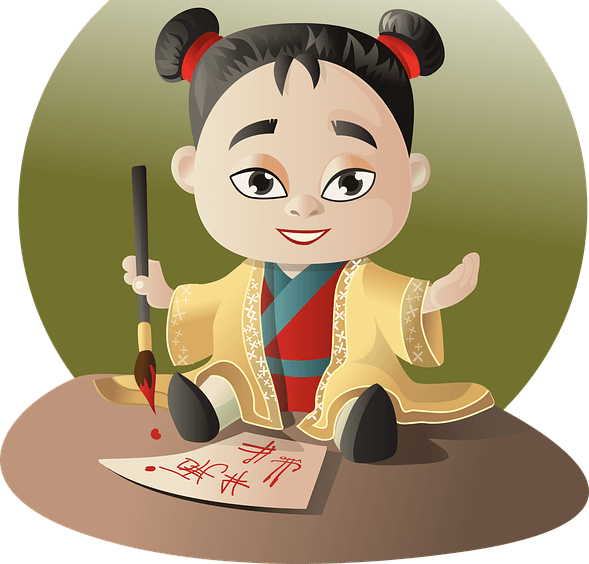
5 Exceptional Reasons to Learn Mandarin & Chinese Language
One comment.
my name is haleema sadia .im from india .im 18 yrs old.i love chinese culture and languagei started studying chinese from 2 months.i want to visit china as soon as possible.
Leave a Reply Cancel reply
Your email address will not be published. Required fields are marked *
Please enter an answer in digits: eight − seven =
Currently you have JavaScript disabled. In order to post comments, please make sure JavaScript and Cookies are enabled, and reload the page. Click here for instructions on how to enable JavaScript in your browser.
Chinese immigrants in the U.S Essay
Introduction.
The history of migration and immigration of communities across the world has been considerably long and debatable following a number of unforeseen circumstances that result from such activities.
There have been substantial arguments rising from communities living in world-renowned cities with issues regarding discrimination, nepotism, and prejudice lingering among them. Currently, population surge within big cities and towns across the world might have resulted from much immigration activities that historically have been part of global discussions (Yin 12).
The story of Chinese migration in the United States has been in constant documentation in literature, with its initial immigration story quite long and tantalizing. Numerous socio-economic motivational factors might have influenced Chinese first immigration to North America (Yin 13). This essay seeks to examine the Chinese immigration to the United States and its impacts.
History of Chinese immigrants
The Chinese American history is typically a story that entails ethnic Chinese or Chinese Americans migration and immigration activities into the US, which is distinguished in three major immigration waves beginning with the 17 century.
The history of the Chinese Americans’ immigration into the United States is a long historical issue that literature is always anticipating to cover and somehow tormenting for those who experienced real events while somewhat fruitful for the modern immigrants (Olson 4).
According to literature documented by Olson, the immigration trends associating the Chinese people into the US began as early as 1700 century when in the 1780s, a group of approximately 100 Chinese explorers journeyed Pacific Ocean towards North America (4).
They decided to settle on the Western coast of Canada and subsequently began exploring the Northwest of Pacific Ocean (Olson 4). A continued influx of Chinese migrants from China slowly began surging into the US thus occupying few regions that finally became populated with Chinese American towards the 1800s, with Lewis and Clark, who were American explorers, marking important events.
Chinese American immigration in 1800s-1900s
The mid-1800 century witnessed substantial immigration trends of Chinese Americans, with several Chinese men traversing the US to join their earlier fellow fortune hunters (Olson 4). This move was in the 1850s when thousands of Chinese populace flocked into the US with their major focus directly intended to occupying the present-day California.
The notion behind this immigration trend towards California at the time hinged upon accounts of the gold rush or simply presence of gold in the American West, especially in California (Olson 4). At this time, fortunately or unfortunately, few Chinese men found the unintended fortune that included working as cooks, labourers, servants, and even launderers (Olson 4).
Factually, as postulated by Olson, “by the 1860s, most of the California’s gold had been mined and Chinese fortune looked elsewhere to make money” (4). During this crucial moment before fortune hunters could imagine of the aggravation, the United States needed railroad and the Central Pacific Railroad of the US was currently employing labourers to engage in land clearing and laying tracks.
The United States, during this epoch, wanted to construct a railroad that would connect the gradually developing western terrain with the already established Eastern States. Since the Chinese fortune hunters for gold could no longer access the gold itself, most Chinese labourers opted to join the construction workforce to build America’s earliest transcontinental railroad and others became agricultural labourers (Olson 4).
The immigration trends involving Chinese immigrants gradually became uncontrollable as it approached the 1880s, only twenty years from the gold rush disappointment and at this time, there were approximately 300, 000 Chinese American residing in the US (Olson 4).
A majority of the Chinese immigrants occupying California as manual contract labourers began experiencing torment since they possessed very little personal freedom, although this has normally appeared as a common historical fallacy to those who understand the history well (Yin 14). This moment marked a great wave of immigration of not only Chinese immigrants, but also millions of new communities that were assembling in cities and towns within the US.
Motivations for Chinese migration to the U.S
A continuum of intertwined factors from social, economic, and political issues might have contributed to the unending Chinese Americans’ migration trends that accustomed the American nation back in the years (Behnke 4).
According to Behnke’s own presumptions, “immigrants have many different reasons for leaving home and they may leave homes to escape poverty, war, or harsh governments, or even want better living conditions for themselves and their children” (4).
The case of motivational factors that triggered Chinese American immigrants is no expectation from the aforementioned issues articulated under such presumptions. For numerous decades, the US has remained renowned as a nation that proffers many socio-economical opportunities and this aspect might have triggered the Chinese to move to the US (Behnke 4).
Economically, relative to America’s economical reputation coupled with Chinese economic misfortunes of Chinese pre-historical era akin to other immigrants, the majority of Chinese immigrants were running away from poverty, hardships, and even the emergence of Taiping Rebellion (Chen 15). Therefore, the aspiration to change their future was the first motivational factor that stirred them.
Gold has been the most precious natural resource that almost each human being anticipates to possess. According to Yin, among the major motivational factors that triggered the movement of Chinese immigrants into the US was the presence and discoveries of gold around John Sutter’s Sawmill by around 24 th of January 1848 (12).
Yin affirms, “Although some individuals arrived in the New World as early as the eighteenth century, it was until the Gold Rush years that Chinese immigration became large enough to have a significant impact on the American society” (12). In essence, the discovery of gold in California was the most motivational aspect that precipitated enormous immigrations continentally into the US.
At this time, informants were becoming more dexterous in producing and disseminating gold-related information that connected the US to great riches, hence making the Chinese overwhelmingly convinced to visit this country of opportunities (Yin 14). Notions of Americans as wealthy people and fortune hunters tales began penetrating into Guangzhou (Canton), which was China’s south provincial capital, thus subsequently rising migration morale.
Harsh political realities of the 1800 century were among the major reasons that motivated the Chinese immigrants to seek peace in the US. Apart from the Gold rush and Gold Mountains, remunerative wages as well as the Chinese imaginings to shape their future living standards and political repression factors have a significant contribution as impellent factors of Chinese immigration to the US. Economic situation was more catastrophic, particularly in Guangdong province in China and with little recovery from devastative events of Opium War, the Chinese could not anticipate for any better living in their homeland (Yin 13).
Coupled with their inability to meet the unremitting taxes following impositions by the Qing government that enacted the treaty of Nanjing-based on British terms, peasants and farmers were forced by that regime to sell their possessions including land and this element impelled them to seek abode in the US in 1850s (Yin 13). Subsequently, to discourage peasants from joining rebels, the Qing regime adopted extreme terrorism policy to execute males from villages that supported rebels, which impelled them to leave their motherland.
Development of anti-Chinese sentiments in the late 1800s
The Chinese immigration and settlement into the US did not receive a soft landing as Native Americans felt the itch of these migration events. As economic hardships, internal turmoil, and favorable rich America reports and cheap ship fares propelled massive Chinese immigration, the American government was eying on these movements (Chen 93).
As businesses across the ocean commenced with a massive influx of Chinese immigration activities that had began being much welcomed due to Chinese aptitude to provide the much-required labor force, the American government had no much interest in the initial period (Chan 98).
The stalemate gradually began when Native Americans noticed the devastating American economy that was by then undergoing depression with jobs becoming scarce and the first thing they thought of was getting rid of the Chinese immigrants (Olson 6). This move attracted attrition between the Native Americans and the Chinese over the dwindling vacancies, with the Americans blaming the Chinese immigrants of the economic misfortune and this element pushed the natives to seek ways of evicting the aliens.
Average Americans and their government as well-considered early migration trends characterized by normal sailing, merchandizing and domestic matters as minor curiosities (Yin 15).
Gradually, news about the confrontation between the Chinese immigrants and the Native American was spreading rapidly, which led to the American government intervention. This intervention led to the development of anti-Chinese sentiments fueled by aggravations and the US government first intervened in 1882 when the congress imposed the Chinese Execution Act, which led to a dramatic decrease of Chinese immigrants from the approximated 105,465 people to 61,639 in the 1920s (Chen 155).
Californians at this moment had already developed innermost grudge against the Chinese as the government’s effort to support deportation of the immigrants triggered discrimination, racial prejudice, and even violence in almost all the entire zones that they occupied (Behnke 5).
According to Yin (16), the 1882 Chinese Exclusion Act barred the Chinese from acquiring American citizenship and the Chinese reputation in the US was constantly dwindling from what the Americans crowned them for, including their industriousness and honestly.
How Chinese Immigration in the 1800’s impacted the United States
After the Chinese migration into the US solidified following their craving for equity and justice in the country, which resulted from their triumphant retaliation against the discriminatory laws and regulations, they finally settled and attracted even more immigrants into the country (Chan 99).
Subsequently, the Chinese women population that was initially restricted began surging in the country to establish complete settlements with their husbands and families in California and other American States (Chan 94). Noticeably, the favourable reception that the early Chinese immigrants enjoyed had already created much impact on the United States stretching from social, cultural, to economical influence to the American society (Yin 16).
In essence, as pressure on the Chinese reduced and political pressure on their eviction vanished, the Chinese began participation in several socio-cultural activities accustomed to the American Natives. With their women and children, the Chinese immigrants filled almost all cities and towns in the US and their interaction with the Americans created a mixture of communal association, while contributing to both affirmative and negative impacts.
Affirmative contributions of Chinese Americans
Chinese immigrants did not only flavor the American nation with a blend of cultures, but they also had quite a significant contribution to the growth and development of the present-day United States (Olson 8).
China possessed strong artistic skills, which is among the reasons why they have managed to survive the hostilities in the US as the experiences in incorporating true-life stories to art became Americans’ anticipation. Behnke posits, “Despite struggling to survive through prejudice, discrimination, and violence, Chinese Americans went on to make important contributions to science, art, literature, music, film, and business in their new country” (5).
The consumption of the Chinese artistic culture was growing rapidly, Americans were becoming fond of it, and coupled with their merchandising and crafts skills, the American society began changing their perceptions against the Chinese immigrants (Behnke 6). Chinese immigrants and other immigrants from various parts of Southern Europe, Eastern, and Asian regions increased during the crucial American industrial era, consequently contributing to the American growth.
As Chinese merchants were becoming busier creating trading routes and connections between Western Asia and Europe trading with Chinese silk and other homemade goods, numerous Chinese migrants were busy seeking opportunities to work in different sectors in the American interior (Behnke 10). While the harsh conditions in their homeland could not allow talented Chinese farmers to practice farming on their own soil, the art of farming that has currently deepened its roots in the US was by then cherished (Chan 105).
In fact, as postulated by Olson (6), the attrition between the Native Americans and the Chinese immigrants due to the United States’ economic misfortunes hardened them even more and forced them to seek a different kind of jobs in restaurants, laundries, small factories, and homes subsequently influencing economic growth.
According to the literature documented by Yin (118), apart from economical and cultural influence, in learning and education, the Chinese American literature grew exponentially within American schools and this aspect contributed to several aspects of education in the contemporary United States.
Negative contributions of Chinese Americans
The immigration of Chinese nationalists into the United States might not have been actually tasty and much of the events happening in the country might have resulted from such Chinese emigrational events.
As postulated by Yin (11) the Chinese immigration in the US has a history of plea and protest against discriminatory coupled with laws that impel mistreatment, something that is not actually bad. However, these processions have greatly attributed to the erosion of significant rules and regulations that might have been imperative in controlling illegal immigration in the US (Behnke 8).
The immigration trends of the 1800s triggered by the stubborn and needy Chinese might have contributed heavily to the insecurity ramifications in the US fuelled by pounding immigration into the current America, with any race fighting for space and inclusion in American soil (Chen 142). To the later, the scramble for inclusion of numerous races in the US is quite evitable with great fear of terrorism attacks and other security matters salient in the entire United States.
The first legislation of its kind that recorded great history in the US was the aforementioned Exclusion Act of 1882 that barred Chinese women, who were Chinese labourers’ wives, from visiting the United States (Chan 96).
Back to the Chinese traditions, the Chinese society has been patriarchal and the only tolerable role for the married Chinese women by that moment were serving their husbands, parents-in-law, and bearing children (Chan 95). Such issues became historical when Chinese women began inflowing into the US following the abolition of the Exclusion Act and this ruling provided women with favourable conditions to migrate to the US (Chan 98).
The presence of Chinese women in the US did not only spur Chinese immigration into the US, but there was also a perception of staining major American cities with indecent behaviours. Chan (104) asserts that since Chinese men labourers were still earning meagre wages, their women decided to find possible means of supporting their husbands, and finally they ended engaging in unlawful prostitution that tinted the American cities.
The modern Chinese Americans
Finally, Chinese immigrants managed to conquer almost all discriminatory regulations by fighting on civil-liberty grounds, subsequently leading to an influx of massive Chinese populace to seeking abode in the US (Behnke 19).
The American congress in 1943 harmoniously withdrew the Chinese Exclusion Act, and in few years, the United States had set its focus on the World War II, thus giving an opportunity to immigration again. In the mid to late 1900s, Chinese immigration into the US increased substantially. Currently, approximately 10 million Asian people in total have managed to acquire American citizenship and settled in the US, with Chinese Americans making the largest populace (Olson 7).
Contemporary, a stroll around the United States’ major cities is reminiscent of traveling several countries continentally, with groceries and shops offering foreign products and selling international foods (Behnke 4). Chinese Americans are currently the most spread and populated immigrants occupying the largest portion of Native American immigrants in the modern days.
Based on the recent 2000 US census, Chinese Americans are approximately 2.4 million with permanent settlements in the US (Behnke 5). Generally, combined with other Asian Americans and Pacific Islanders, they sum up to about 16 million immigrants residing in the US.
Chinese Americans are still suffering from poor communication in the US given the fact that during immigration, few of them managed to muddle through the US educational system (Yin 19). English proficiency in the Chinese Americans in the modern days gives them a hard time to cope with the ever-changing American lifestyle, including unrelenting medical challenges as chronic cancer and hepatitis B that kills thousands of them annually (Yin 130).
Still dwelling in low-cost rentals and others in America’s rural suburbs, Chinese are still suffering from discrimination and prejudice despite their great contribution to the growth and development of the American economical, social, and cultural endeavors. The majority are still languishing in poverty and living below the United States’ poverty line.
Scarcity of reliable sources may hamper the ability to determine the exact dates when the Chinese officially began migrating to the United States. Nonetheless, substantial literature links the events of the 1850s in China to the beginning of serious Chinese emigrational activities towards the US.
The Chinese immigration of 1800s into the US might have been very influential in triggering transnational migration towards the country with tales of California Gold, political, and economic misfortunes behind such movements. Chinese Americans have undergone severe torment prior to their emigrational activities to the US, including racial discrimination and prejudice.
Currently, despite having acquired permanent settlement and citizenships, Chinese Americans are still suffering from discrimination, ethnic bias, and healthcare inequalities following their inabilities to communicate proficiently in English. Intuitively, immigration to the US might never halt following its closer connection with wealth and power, especially in the current decades and Asians are still on the move to find fortunes in the US.
Works Cited
Behnke, Alison. Chinese in America, Minneapolis : Lerner Publications, 2005. Print.
Chan, Sucheng. The exclusion of Chinese women 1870-1943, Washington, DC: Government Printing Office, 1875. Print.
Chen, Jack. The Chinese of America , New York: Harper & Row Publishers, 1980. Print.
Olson, Kay. Chinese Immigrants, 1850-1900, Minnesota: Capstone Publisher, 2002. Print.
Yin, Xiao-Huang. Chinese American Literature since the 1850s, Illinois: University of Illinois Press, 2000. Print.
- Chicago (A-D)
- Chicago (N-B)
IvyPanda. (2020, March 5). Chinese immigrants in the U.S. https://ivypanda.com/essays/chinese-immigrants-in-the-u-s/
"Chinese immigrants in the U.S." IvyPanda , 5 Mar. 2020, ivypanda.com/essays/chinese-immigrants-in-the-u-s/.
IvyPanda . (2020) 'Chinese immigrants in the U.S'. 5 March.
IvyPanda . 2020. "Chinese immigrants in the U.S." March 5, 2020. https://ivypanda.com/essays/chinese-immigrants-in-the-u-s/.
1. IvyPanda . "Chinese immigrants in the U.S." March 5, 2020. https://ivypanda.com/essays/chinese-immigrants-in-the-u-s/.
Bibliography
IvyPanda . "Chinese immigrants in the U.S." March 5, 2020. https://ivypanda.com/essays/chinese-immigrants-in-the-u-s/.
- Global labour migration and global cities' labour markets
- Colonisation and Drug Trade
- The Immigration Benefits
- The Great Migration Causes and Effects
- Reasons for Earning Different Wages
- Management practice by Fredrick Taylor
- Boycotting American Goods Movement
- Impact of the Black Death
- Older People and the Labour Market in Australia
- William Moraley Biography
- Myths About Immigration in the U.S.
- Mexican Immigrants in Carolina
- Assimilation in American Life
- Immigration, Socioeconomic and Upward Mobility and Cultural Assimilation
- The Success of the Second Generation Immigrants

Finished Papers
How It Works
Customer Reviews
The narration in my narrative work needs to be smooth and appealing to the readers while writing my essay. Our writers enhance the elements in the writing as per the demand of such a narrative piece that interests the readers and urges them to read along with the entire writing.
Finished Papers
How can I be sure you will write my paper, and it is not a scam?
Adam dobrinich, transparency through our essay writing service.
Transparency is unique to our company and for my writing essay services. You will get to know everything about 'my order' that you have placed. If you want to check the continuity of the order and how the overall essay is being made, you can simply ask for 'my draft' done so far through your 'my account' section. To make changes in your work, you can simply pass on your revision to the writers via the online customer support chat. After getting ‘my’ initial draft in hand, you can go for unlimited revisions for free, in case you are not satisfied with any content of the draft. We will be constantly there by your side and will provide you with every kind of assistance with our best essay writing service.
Customer Reviews

Estelle Gallagher
Finished Papers
Customer Reviews

IMAGES
VIDEO
COMMENTS
Here are tips to help you get better at writing essays in Chinese. Cover image from Pexels Learn New Chinese Words. The key to communicating in a new language is learning as many words as you can. Take it upon yourself to learn at least one Chinese word a day. Chinese words are to essay writing what bricks are to a building.
Takeaway to Improve Chinese Essay Writing. Keep an excel spreadsheet of 口语 (Kǒuyǔ, spoken Chinese) -书面语 (Shūmiànyǔ, written Chinese) pairs and quotes of sentences that you like. You should also be marking up books and articles that you read looking for new ways of expressing ideas. Using Chinese-Chinese dictionaries is really ...
Chinese Essay Phrases Used in Abstracts. The abstract should explain the purpose, method, results, and conclusion of your research, also highlighting the new ideas that you proposed; and do remember to keep your language concise while writing. The purpose of the abstract is to conclude and summarize the main contents of your essay so that the ...
2. Determine the center, choose the right material. To conform to the fact that a typical, novel, so it's easy to attract the attention of people. 3. Make a good outline, determine the general, write enough words. 4. Sentence writing smooth, there is no wrong character, no wrong grammar in article. Emotion, it is very important.
Final Thoughts. Writing Mandarin is a challenging task that will test your language skills and make you think hard about how to apply what you've learned so far. It might be slow going to begin with, but that's great as it means you're pushing your limits and building on your existing skills. If you want to be able to master Mandarin, you ...
Writing is in this sense a result of learning, not the cause of it. Read as much as you can; read extensively. Read narrowly - Because reading is so important for improving writing ability, I'll bring up another way of reading that can be particularly helpful: narrow reading.
10 Useful Words for Writing Essays in Mandarin Chinese: https://youtu.be/h24nSlnOet0** [Grammar used in this video]: 👇⭐️ The most often used Chinese word 的 ...
18. When analyzing Chinese speeches or essays, I often have difficulty understanding how their the authors organized their ideas. In North America, for example, a common template for writing an essay is the five-paragraph essay. This organizes the paragraphs and the sentences within each paragraph. Most English-language writing in academia ...
As a Chinese student, learning how to write an essay in this language is very important. Here are tips to help you get better at writing essays in Chinese. You can also enter a city, course or keyword to search, such as: Private Shanghai Location Online Beijing Shanghai
Before we even talk about what to write, we must first know what will be tested. For GCE O level Chinese exam, essay writing is in section 2 of Paper 1. In this section, students are expected to choose to write 1 out of 3 questions, and the 3 questions will be in one of the following categories: 情景文 (Scenario essay writing) 说明文 ...
10 Useful Words for Writing Essays in Mandarin Chinese 不但...,而且...: https://youtu.be/EJnKych4BvU
2" " " Foreignwordswrittenin "pinyin"(butnotpropernames!) are"usually"italicized inthemain"text. "" The qipao"becamepopular"inShanghaiduringthelate1920s ...
First we went from components to characters. Next, we are going from characters to words. Although there are a lot of one-character words in Chinese, they tend to either be classically-rooted words like "king" and "horse" or grammatical particles and pronouns. The vast majority of Chinese words contain two characters.
This is especially true of Classical Chinese. One style of essay writing is not superior to another, but is rather a result of historical circumstances and cultural tradition. It is, however, very important for students to learn the North American style of essay writing since it is required and expected in all university writing and, of
An essay from Chinese lit diva Zhang Ailing about a scene of police brutality she witnessed in Shanghai in the 1940s. HSK 6 and up. ... This is a noble, elevating piece of writing, and reading it, I'm reminded that in all societies, there are those who struggle with the materialism that engulfs us. Tags Essays; Categories. Beginner. Essay ...
36 samples of Chinese handwriting from students and native speakers. Unlike most other languages, handwriting in Chinese can be regarded as a separate skill. Learning to write by hand is not easy; learning to write well is even harder. In an earlier article, I discussed handwriting in details, including how to improve it as a student.
In your open AI project, select your 'Output Language' from the dropdown menu. 2. Fill in the prompts in any language - the same as the chosen for the output, or any other. 3. Then, click 'Generate'. 4. Check the options provided by AI, choose a result, and use it in your project. Write Any Kind of Copy.
For a start, I have prepared three articles below with audio on self-introduction speech examples, changing the variation of replies in Chinese for beginners when you introduce yourself in Mandarin. The questions and answers will revolve around: -. ① Chinese Greetings and Pronouns. ② Your Name and Surname. ③ Your Age.
All these festivals may be classified under four categories (Gibney, p. 109). This paper will focus on the three Chinese traditional festivals. These are the Spring Festival, the Mid-Autumn Festival and the Dragon Boat festival. This paper will briefly describe the three festivals and their importance to the Chinese people.
The story of Chinese migration in the United States has been in constant documentation in literature, with its initial immigration story quite long and tantalizing. Numerous socio-economic motivational factors might have influenced Chinese first immigration to North America (Yin 13). This essay seeks to examine the Chinese immigration to the ...
Get a free quote from our professional essay writing service and an idea of how much the paper will cost before it even begins. If the price is satisfactory, accept the bid and watch your concerns slowly fade away! Our team will make sure that staying up until 4 am becomes a thing of the past. The essay service is known for providing some of ...
Please, Write My Essay for Me! Congratulations, now you are the wittiest student in your classroom, the one who knows the trick of successful and effortless studying. The magical spell sounds like this: "Write my essay for me!" To make that spell work, you just need to contact us and place your order. If you are not sure that ordering an essay ...
The second you place your "write an essay for me" request, numerous writers will be bidding on your work. It is up to you to choose the right specialist for your task. Make an educated choice by reading their bios, analyzing their order stats, and looking over their reviews. Our essay writers are required to identify their areas of interest so ...